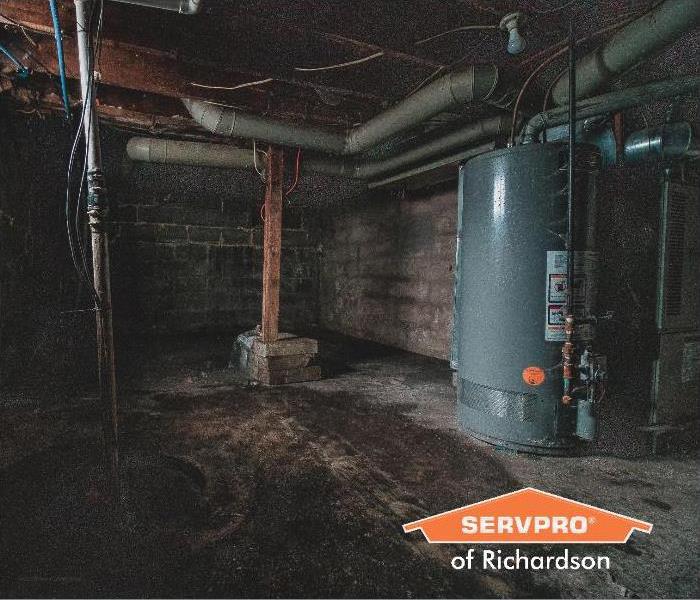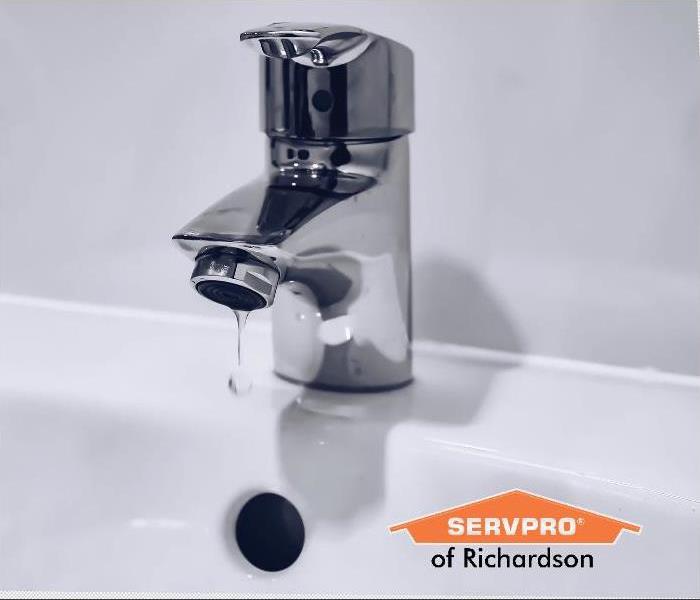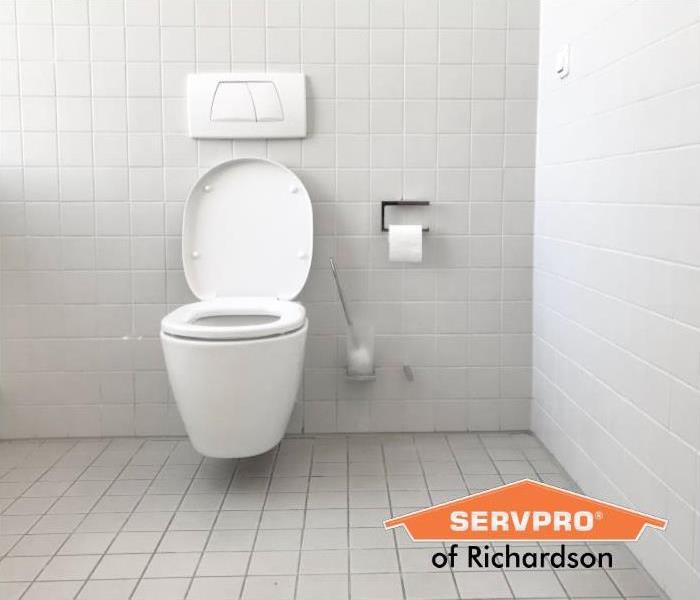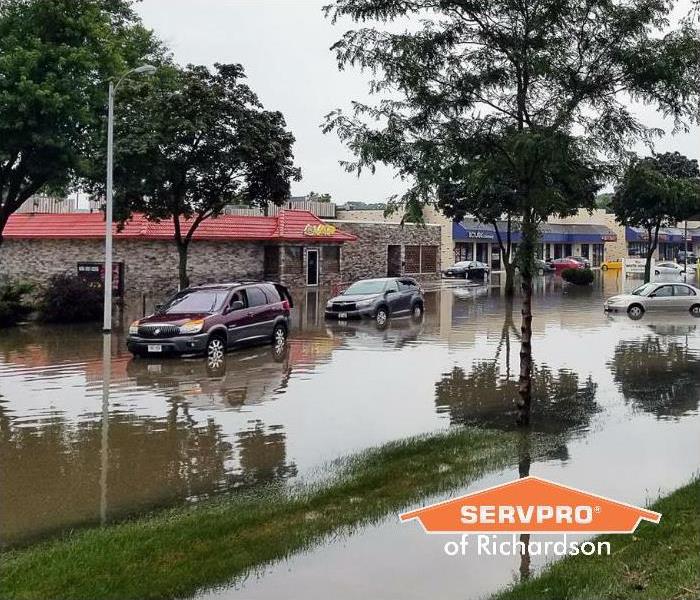Recent Water Damage Posts
Post-Rainstorm Checklist: What to Look for to Detect Leaks in Your Home
4/1/2024 (Permalink)
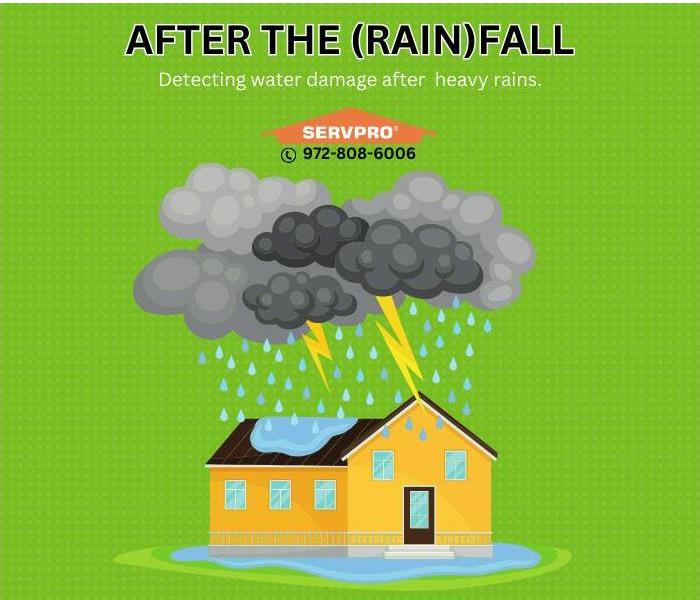 A checklist for finding water damage after a heavy rainfall.
A checklist for finding water damage after a heavy rainfall.
After a heavy rainstorm, it's essential to inspect your home for any signs of water intrusion or leaks. Here's a checklist of what to look for when checking for leaks after a downpour:
Roof: Start by inspecting your roof for any visible signs of damage, such as missing or damaged shingles, cracked flashing, or sagging areas. Look for water stains on the ceiling or walls in the attic, as these may indicate a roof leak.
Gutters and Downspouts: Check your gutters and downspouts for clogs or debris that could impede water flow. Ensure that gutters are securely attached to the roofline and that downspouts direct water away from the foundation of your home.
Windows and Doors: Inspect the seals around windows and doors for any gaps or cracks where water could enter. Check for signs of water intrusion, such as water stains or swollen wood frames.
Walls and Ceilings: Look for water stains, bulging, or peeling paint on walls and ceilings, which may indicate hidden leaks. Pay special attention to areas near windows, doors, and plumbing fixtures.
Plumbing Fixtures: Check under sinks, around toilets, and behind appliances for any signs of water leaks, such as puddles or dampness. Inspect plumbing pipes for signs of corrosion, rust, or damage.
Attic: If accessible, inspect the attic for signs of water intrusion, such as water stains, mold growth, or damp insulation. Check around vents, chimneys, and skylights for signs of leaks.
Exterior Walls and Siding: Inspect the exterior walls and siding of your home for any cracks, gaps, or damage that could allow water to enter. Look for signs of water stains or rotting wood.
By conducting a thorough inspection of your home after a heavy rainstorm and addressing any potential leaks or water damage promptly, you can help protect your home from costly repairs and ensure a safe and dry living environment.
If you find signs of a leak - make sure to call SERVPRO of Richardson (972-808-6006.)
We know how to quickly assess and address water damages.
You Called Us - Now What?
4/1/2024 (Permalink)
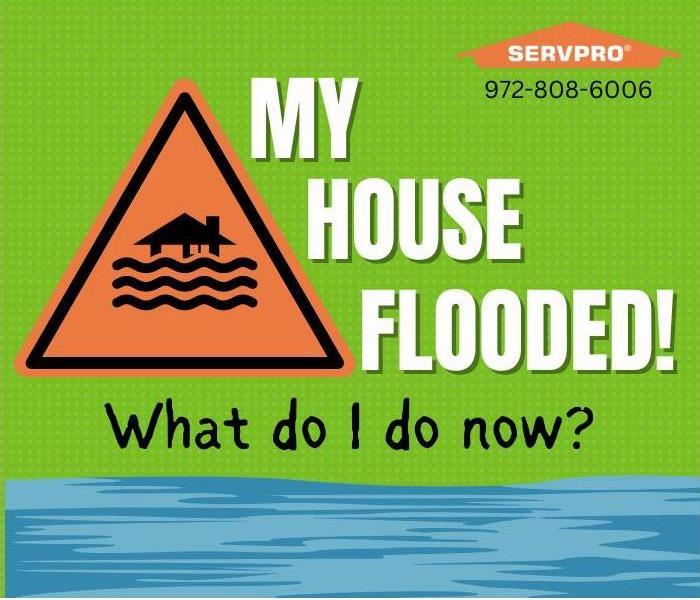 Call SERVPRO of Richardson if your house floods.
Call SERVPRO of Richardson if your house floods.
Experiencing a flood in your home can be a stressful and overwhelming situation, but SERVPRO of Richardson has a team of experts that can assess and address water damage.
Call us right away - but you can also help minimize damage and expedite the recovery process. Here are essential steps to take before SERVPRO gets there:
Prioritize Safety: Safety should always come first. Before taking any action, ensure that it's safe to enter your home. Turn off the electricity and gas supply to prevent the risk of electrical shocks or gas leaks. Avoid walking through floodwaters, as they may contain harmful contaminants or hide hazards.
Assess the Damage: Take photographs or videos of the flooded areas for insurance purposes. Document any visible damage to furniture, appliances, walls, and flooring.
Protect Belongings: Salvage any items that haven't been damaged by the floodwaters. Move them to a dry, well-ventilated area to prevent further deterioration. SERVPRO will help dispose of carpet and furniture that cannot be repaired.
Remove Water: Start the process of water removal as soon as possible to prevent further damage and mold growth. Use a wet vacuum, buckets or even towels to remove standing water from the affected areas. If possible, block off affected areas to prevent water from spreading. Place aluminum foil or wood blocks under furniture legs to prevent them from absorbing moisture from the floor. Open doors and windows to improve ventilation and aid in the drying process.
Document Everything: Keep detailed records of all cleanup and mitigation efforts, including photographs, videos, and written notes. This documentation will be essential when filing insurance claims and working with restoration professionals.
Taking these proactive steps before professional help arrives can help mitigate damage, expedite the restoration process, and ensure the safety of you and your family.
While dealing with a house flood can be challenging, acting quickly and decisively can make a significant difference in the outcome.
Call Us 24 Hours a Day, 7 Days a Week
2/12/2023 (Permalink)
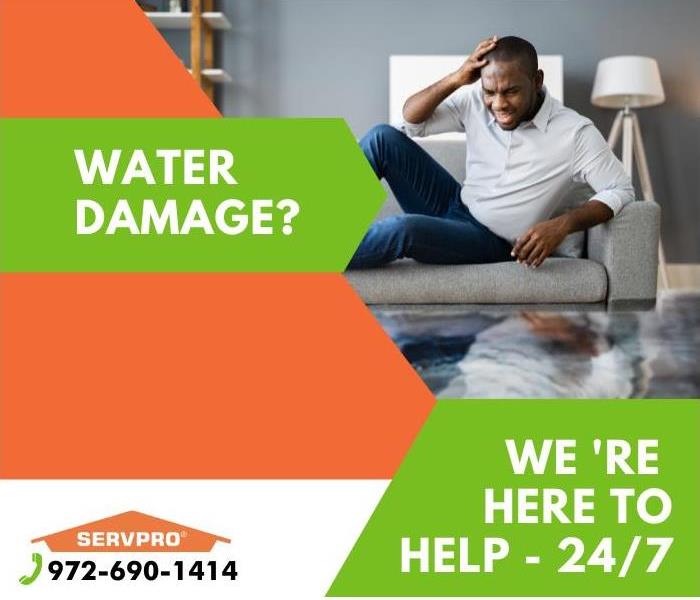 SERVPRO of Richardson is available to help 24 hours a day, 7 days a week.
SERVPRO of Richardson is available to help 24 hours a day, 7 days a week.
SERVPRO of Richardson is available 24 hours a day for water emergencies, large or small. When you are dealing with water damage, immediate action is crucial. A delay of just a few hours can greatly increase the severity of the water damage.
We're Always Ready to Help
Call Today (972)690-1414
We understand that when you call us, you may be feeling confused, stressed, and vulnerable. You need an expert to guide you through this crisis. SERVPRO of Richardson has the specific water damage training and experience to help you through this tough time. We specialize in water damage restoration—in fact, it's the cornerstone of our business.
What to Expect
When you call, we will ask several questions regarding your water damage emergency. These questions will help us determine what equipment and resources to bring, including how many trained SERVPRO professionals may be needed.
Our SERVPRO Representative will ask questions such as these:
- Your name and contact information
- Your insurance information (if applicable)
- The street address of the water-damaged home or business
- When did the flooding or water damage occur?
- What caused the water damage (if known)?
- Is there electricity available (on-site)?
About SERVPRO of Richardson
SERVPRO of Richardson specializes in the cleanup and restoration of residential and commercial property after a fire, smoke or water damage event. Our staff is highly trained in property damage restoration. From initial and ongoing training at SERVPRO’s corporate training facility to regular IICRC-industry certification, rest assured our staff is equipped with the knowledge to restore your property.
Your Meter Can Detect a Leak
2/12/2023 (Permalink)
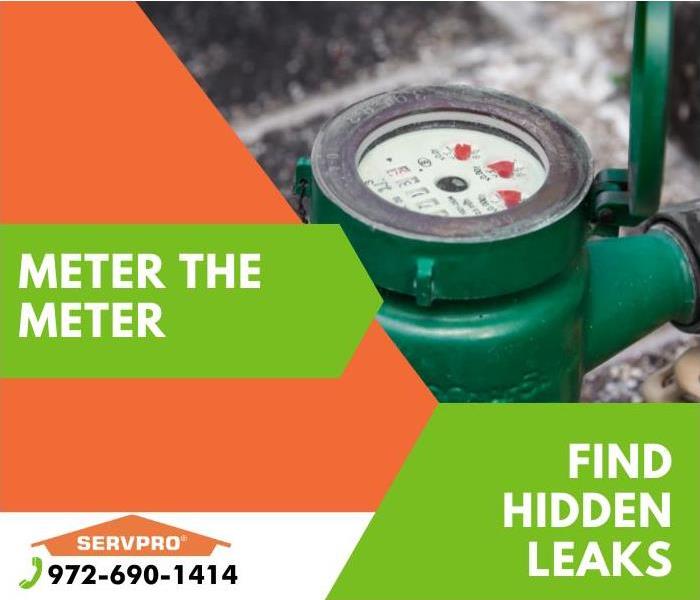 Your water meter can help uncover hidden leaks.
Your water meter can help uncover hidden leaks.
Did you know that your water meter can help identify hidden leaks at home?
While some plumbing leaks are obvious, others aren't and can cause extensive damage in your home. Most pipes are behind drywall, which is pleasing to the eye but not conducive to catching leaks.
These hidden issues within our pipes can be the result of many different problems, such as sediment buildup or acidic water, but are more commonly the result of wear and tear due to old age. If leaks go unnoticed for an extended period of time they can lead to an unstable structure, or worse, mold.
But you can use your meter to help find hidden leaks and avoid potential damage.
Follow These Steps
- Don't use any water for at least 20 minutes, and then check the leak indicator on your meter. If the indicator is moving - you possibly have a leak.
- Write down the numbers from the meter and then go an additional hour without using any water in your home. Check the meter again and if the numbers have changed then it is highly likely you have a leak.
- You can narrow down the location or your leak by shutting the water completely off and then rechecking the meter. If the indicator stopped moving once the water is off - that means the leak is happening inside your home. If it continues to move then the leak is outside.
- Call a plumber to help uncover the exact location and fix the leak.
- Then, call SERVPRO of Richardson to help clean up any damage - even if it's behind the walls.
Is it Safe to Use a Humidifier in a Carpeted Room?
2/10/2022 (Permalink)
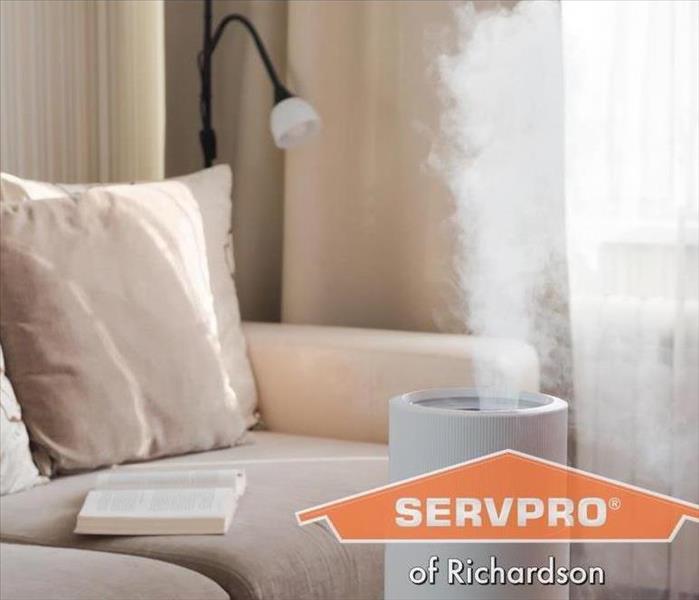 Mold growth caused by excessive moisture and humidity is a serious problem after a flood or water damage.
Mold growth caused by excessive moisture and humidity is a serious problem after a flood or water damage.
You might be wondering if you can use a humidifier in a carpeted room if you need to boost air moisture levels. Humidifiers are handy appliances that can ease the discomfort caused by dry air. People use them to alleviate dry skin, cold or flu symptoms, or allergies. Additionally, certain house plants will grow better in a humid environment.
However, there’s one major issue that many people forget with humidifiers — mold. Elevated moisture levels in a room can promote mold growth, mildew, and dust mites. And a dirty humidifier can send mold spores into the air.
But is using a humidifier in a carpeted room a good idea? Using a humidifier in a room with a carpeted floor could be a bad idea if air moisture levels are too high. Although an excessive level of humidity may not make your carpet wet, it can create an environment where mold spores thrive. And dampness can stay in a carpet longer than on a hard floor, causing mold to develop, which can be challenging to remove.
Effects of Using a Humidifier in a Carpeted Room
Mold thrives in damp, cool indoor environments. According to the Environment Protection Agency (EPA), mold frequently grows on carpets, wood, paper, food, and insulation. Because mold spores are virtually impossible to eliminate, controlling indoor moisture is vital for preventing the growth of mold.
One of the dangers of using a humidifier in a carpeted room is that the mold grows unseen. For example, the EPA says that the underside of carpets and rugs are common locations of hidden moisture and mold growth.
Of course, it’s not just humidifiers that cause excess moisture in the air. Other reasons for high humidity levels are steam radiators, cooking, showering, and dryers.
Experts agree that indoor relative humidity should not exceed 60 percent. The ideal relative humidity is between 30 and 50 percent.
Can a Humidifier Cause Mold in a Carpet?
A humidifier can be unsafe to use in a carpeted room because it can harbor mold spores and hide black mold patches. A 2020 study in the journal Building and Environment reported that fungal growth occurs in carpet fibers under elevated moisture conditions.
Fungal allergens and other microorganisms are commonly found in carpet fibers, and carpets hold more moisture than the surrounding room air.
The study concluded that high relative humidity is one of the most crucial factors contributing to a carpet’s fungal growth.
In addition, it isn’t safe to place a humidifier on a carpet because it increases the risk of being knocked over.
Mold growth caused by excessive moisture and humidity is a serious problem after a flood or water damage. SERVPRO specializes in mold remediation to quickly dry out carpets, furnishings, and building structures. Acting fast after a flood or burst pipe is the best way to prevent mold growth.
If your building has suffered water damage, contact us today at (972) 690-1414 to arrange for our team of experts to assess your situation. Richardson mold remediation services can help prevent issues caused by excessive humidity, moisture, and mold growth.
How to Unfreeze Pipes this Winter
2/10/2022 (Permalink)
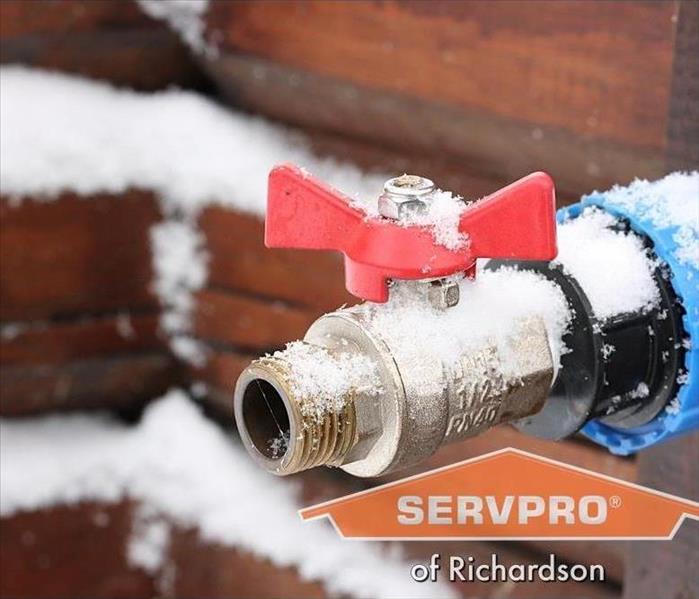 If a pipe bursts as it unfreezes this winter, it’s vital to call a company specializing in water damage restoration.
If a pipe bursts as it unfreezes this winter, it’s vital to call a company specializing in water damage restoration.
Turning the faucet on a cold winter’s morning only to find a trickle of water usually means one thing — frozen pipes. The major problem with an ice blockage in your plumbing system usually happens when you try to unfreeze the pipes. Water expands as it turns to ice. This can cause a crack or split the water lines. Then when the frozen water pipe thaws, a major leak can happen, resulting in expensive damage to repair.
How can you unfreeze pipes this winter if they have frozen? How can you avoid a major flood in your house as the ice in the pipes melts?
This article contains helpful tips on unfreezing pipes and preventing significant water damage when they thaw.
4 Ways to Unfreeze Pipes
Unfreezing a pipe requires finding where the blockage is located, applying some gentle heat, and being ready to clean up any water leakage. However, it can be tricky to find the frozen pipe if it’s in a wall, crawl space, or another hard-to-reach place.
1. Turn off the Main Shutoff Valve
Before attempting to thaw a frozen pipe, the first step is to turn off the main water valve. Doing this prevents a deluge of water from pouring out a pipe if it bursts.
2. Keep the Faucet Open
The next step to unfreeze a pipe is to open the faucets. Allowing the water to flow freely prevents water pressure from building up between the ice blockage and the faucet. This step is the best way of avoiding a burst pipe as it thaws and water pressure returns.
3. Locate the Frozen Section of Pipe
You will now have to locate where the ice blockage has occurred. To do this, you will need to do some detective work. For example, if only one faucet appears blocked, inspect the water lines back from that point. However, if there is no water flow in the house, you must check where the water enters the building.
You can look for condensation or frost on water pipes to find the blockage. It’s also helpful to tap pipes and listen if the sound is solid or hollow. Or you can use your hand to feel where the water line is its coldest.
4. Apply Heat to the Frozen Pipe
There are three suitable ways to unfreeze a pipe. First, you could use a heat lamp or a portable space heater to increase the air temperature around the blockage. Or you can use a hairdryer on a warm setting and gently thaw the ice in the pipe. Another heat source is an electric heating pad or heat cable to melt the ice in the frozen water pipe.
Top tip when unfreezing pipes: Always start from the faucet end of the ice blockage and work back. This prevents tremendous pressure from building up in the pipe.
What To Do if Pipes Burst This Winter?
If a pipe bursts as it unfreezes this winter, it’s vital to call a company specializing in water damage restoration. Cleaning up after a flood isn’t just about removing excess water. It’s crucial to use specialized drying equipment to prevent water damage that results in mold growth or structural issues.
Contact SERVPRO of Richardson (972) 690-1414 today if a burst pipe has caused water damage. Our Richardson water damage restoration services can mitigate all the harmful effects of a flood in your home.
What Kitchen Appliances Cause Water Damage?
1/6/2022 (Permalink)
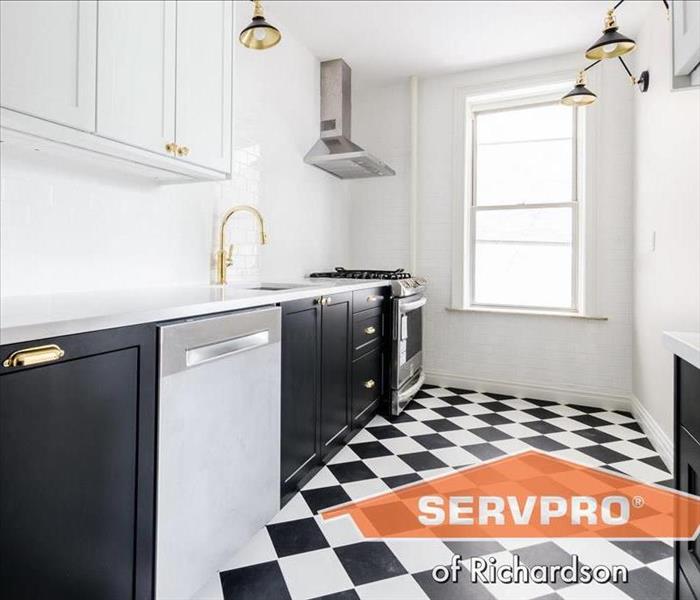 SERVPRO has been in business for 35+ years, making us one of the most established damage restoration service providers out there.
SERVPRO has been in business for 35+ years, making us one of the most established damage restoration service providers out there.
Leaks in the average household can account for nearly 10,000 gallons of wasted water annually. But just as bad as the wasted water is the water damage that leaking or malfunctioning kitchen appliances can cause.
You may not know it, but improper use and failing to inspect your kitchen appliances can cause severe water damage. For this reason, it’s important that you recognize what common kitchen appliances can cause the most water damage — and how to prevent it.
Top Two Kitchen Appliances That Cause Water Damage
Certain appliances in your kitchen rely on water for their usage. But the main two appliances you should be wary of when it comes to preventing water damage are:
1. The Dishwasher
Your dishwasher uses a lot of water for each cycle it runs. Because of this, you should always be careful how you operate it.
If you don’t already have a child lock on your dishwasher, consider getting one. Child safety locks ensure no small children will be able to open your dishwasher doors during operation.
Dishwashers are designed to stop operating once the door is open. But if your dishwasher is malfunctioning, it can still run its cycle with the door open and cause water damage.
Also, adding too much detergent to the dishwasher can cause water damage. When operating your dishwasher, use only the recommended amount of detergent.
2. The Refrigerator
Most refrigerators these days serve filtered water and will always need water to form ice. Due to this, you have to be mindful of the current condition of your refrigerator.
Although durable, the water tubing on your fridge can be damaged over years of use. Eventually, it’s possible that the tubing can break one day, creating a leak that could cause terrible water damage if not detected early.
The most common cause of a leaking refrigerator is when your defrost drain is clogged or freezing. If this happens, you will need to thaw the ice and use hot water to flush your drain. Make sure to check the rubber seals along the door to ensure tightness.
What Happens if Water Damage Occurs?
If water damage has occurred because of malfunctioning kitchen appliances, you will need the professional assistance of Richardson water damage restoration services.
Experts in water damage restoration will use the appropriate tools, devices, and methods to reverse the damage that was dealt to your kitchen.
Call SERVPRO for all Your Water Damage Restoration Needs
SERVPRO has been in business for 35+ years, making us one of the most established damage restoration service providers out there. If you find yourself needing quality water damage restoration, you can count on us.
For any inquiries about our services, call us at (972) 690-1414. Or fill out our online form.
Sneaky Places Mold Can Hide in Your Richardson Home
10/11/2021 (Permalink)
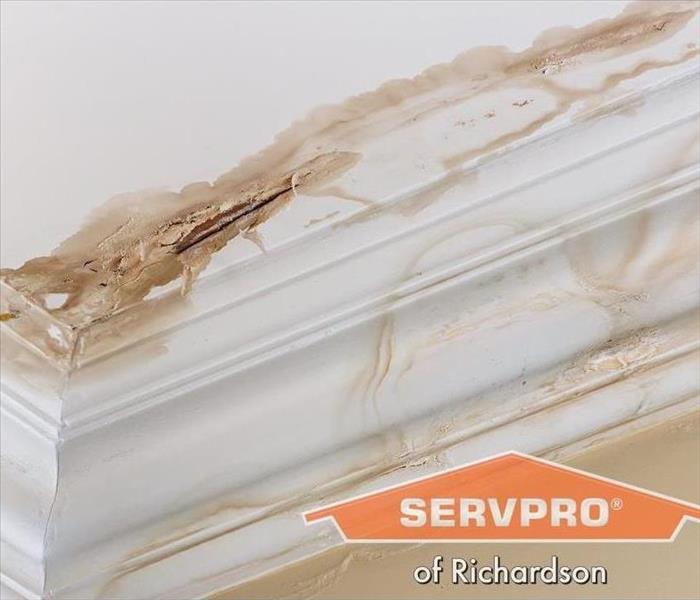 If you find any mold in your Richardson home, it's time to call the professionals.
If you find any mold in your Richardson home, it's time to call the professionals.
Mold can be found anywhere moisture is. It can appear on the floor, in the air, even inside walls. However, mold growth requires three things to form:
- Water intrusion
- A place to grow
- Temperature between 40 - 100 degrees F / 4-38 degrees C
If you have a Richardson home with mold, there's a good chance that it might be hiding out in these five sneaky places.
Call SERVPRO of Richardson at 972-690-1414 to get rid of any visible signs of mold before they spread throughout your home. Our team will get things back to normal before you know it.
1. Drywall
There are plenty of reasons to keep your walls dry. Mold thrives on water, and the longer it's allowed to stay moist, the darker and stronger its roots will grow. Even if there isn't any visible sign of mold yet, damp drywall could just be harboring the spores that lead to mold infestation.
2. Wood or Wood-derived Surfaces
Another culprit for rotting wood is moisture getting trapped behind cellulose materials such as paneling or wallpaper. It may seem like an innocent fix for a problem that is only in the beginning stages, but you might end up with more issues down the line.
3. Air Conditioning Units
Other house appliances such as air conditioning units can also provide mold with the moisture it needs to grow and spread. Not only do these devices need to be kept free of mold themselves but check them regularly to make sure there isn't any leaking where the pipes connect at the exterior of your home.
4. Countertops
As countertops are exposed to plenty of water throughout their lives, they're susceptible to developing mold over time. Cleaning these surfaces too aggressively with common cleaning supplies can also strip the countertops of their natural protection against mold growth, which means that you'll need to be extra cautious when wiping down your counters.
5. Bathroom Sinks and Bathtubs
Water is a leading factor in the growth of mold. As they collect water, these two areas are prime spots for mold to grow behind the fixtures, along grout lines, or under the edge of your tub. One way to check if you have an issue is by wiping down these surfaces with bleach or vinegar—if you see signs of black mold anywhere on the surface, it means that there's hidden mold behind probably everywhere else too.
6. Mattresses
Finally, mold can also be hiding in your bed. Mattresses are particularly vulnerable due to the number of moist hours they spend tucked under sheets and blankets. One small splash could lead to an infestation within weeks.
Get Mold Remediation and Restoration in Richardson
If you find any mold in your Richardson home, it's time to call the professionals.
Sneaky places like these can be tricky to handle yourself, so let the trained pros at SERVPRO of Richardson Mold Remediation and Restoration help. Call (972) 690-1414 today for more information or book an appointment online.
Clothing and Textile Restoration After Flood Damage in Richardson
6/28/2021 (Permalink)
 When returning to a flooded property, take the following steps to ensure your safety and minimize any further damage when salvaging clothing and other
When returning to a flooded property, take the following steps to ensure your safety and minimize any further damage when salvaging clothing and other
Water is one of the most destructive elements. Besides damage to floors, walls, and ceilings, you could also be looking at water-logged clothing and textiles after a flood. What steps do you need to take to save your belongings?
We’ll cover our clothing and textile restoration steps in this article. Contact us today for a free estimate on restoring your water-damaged property in Richardson.
Salvaging Textiles: Precautions to Take
When returning to a flooded property, take the following steps to ensure your safety and minimize any further damage when salvaging clothing and other textiles:
- Soiled garments can be contaminated with bacteria-laden grey and blackwater after a flood. So, wear gloves and tall boots that adequately cover your arms and legs. If the area is dusty and musty, consider wearing a mask.
- Be careful to avoid stretching the fabric. Gently lift water-logged textiles and place them on a solid surface for support when moving the items.
Clothing and Textile Damage From Flooding: What and How to Salvage
Textiles that are beyond at-home cleaning, won’t thoroughly dry, or otherwise fit these categories can still be salvaged by the professionals at SERVPRO of Richardson:
- Have discoloration and stains unlikely to lift in your home washing machine
- Are severely contaminated with fuel oil or sewage
- Are embedded with fiberglass insulation or chemical contaminants
Additionally, very thick clothing or blankets, stuffed animals, and animal beds should not be washed in residential washers and should instead be taken to a professional textile cleaner like SERVPRO. This is because residential washers do not use enough water pressure to properly reach and push the contaminants out of the textile. Likewise, textiles that are delicate should not be put into regular washers because they use agitation to clean which can damage them.
Textiles and clothing that can otherwise be cleaned and dried and aren’t contaminated with the above can be salvaged at home or at a dry cleaner. In that case, you’ll want to separate the items based on whether they must be dry cleaned, machine, or hand washed. Further, sort the items based on color and washing temperature.
Clean, Disinfect, and Pretreat
Floodwater is contaminated with bacteria, so simply drying wet clothes from a flood won’t suffice. You’ll need to disinfect the items with bleach, OxiClean, or a similar disinfectant safe for fabrics.
Clean and sanitize your washing machine with hot water and bleach before you wash machine washable clothing. Then clean and pretreat the items:
- Rewet damp clothes with clean water to wash away debris. Outside with a garden hose is best.
- Dried textiles must be shaken, brushed, or scraped to remove dirt. Then rinse these items with clean, cool water.
Machine Washing Flood-Damaged Textiles:
- Prewash the items to avoid staining. Use cold water with a strong detergent. Only wash a small load, but fill the washing machine to a full level. Use an enzymatic cleaner in the prewash cycle to clean sewage. Rinse, then spin dry. Then, complete the next step before machine drying.
- The next step is to wash the items in the hottest water that’s safe for the fabrics. Use a strong detergent and disinfectant. Repeat until satisfied, then you can dry.
- Drying will set stains, so be sure to remove stains with pre washing and washing before you turn on the dryer. Use the regular setting. But if you’re worried about shrinkage, line dry your items.
- Iron the textiles to kill any remaining germs.
Handwashing:
- Pre rinse with cold water.
- Prewash with a safe detergent and disinfectant
- Wash by hand with the right temp and detergent safe for the fabric.
- Lay flat to dry
- Iron to kill remaining germs
Dry Cleaning:
- Scrape off any mud and debris outside. Do not rinse a dry clean only item.
- Dry the textiles outside in the sun to eliminate mold growth
- Once dry, take the fabrics to a dry cleaner
Restoration After Flood Damage in Richardson
If your property has suffered water damage, give us a call today at (972) 690-1414 for an estimate on our water damage restoration services in Richardson.
Why is My Toilet Overflowing? What Do I Do?
4/26/2021 (Permalink)
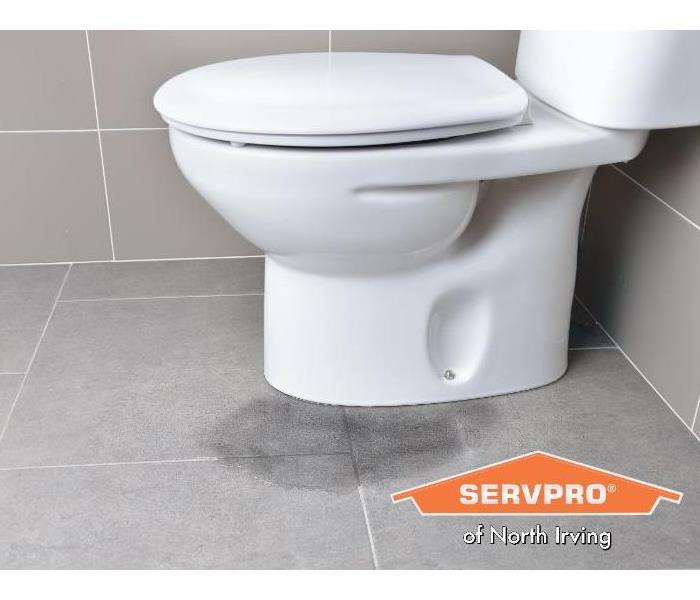 To find a solution for a toilet that overflows, we need to find out why it’s happening. Unaddressed water damage leads to warped flooring and molding.
To find a solution for a toilet that overflows, we need to find out why it’s happening. Unaddressed water damage leads to warped flooring and molding.
If you’ve lost count of how many times you’ve grabbed the toilet plunger or “snake” you’re probably asking yourself “Why does my toilet keep overflowing?”
We understand how frustrating it is when a toilet isn’t flushing properly, so we’ve put together some troubleshooting tips and solutions that may resolve this issue.
Why Your Toilet Clogs and Overflows
To find a solution for a toilet that overflows often, we need to find out why it’s happening. Below are common issues that cause a toilet to not drain properly.
- Older toilet - An old house is likely to have old toilets. In the 1990s, first-generation toilets were designed to be “low flow.” These toilets are notorious for not flushing well, and newer designs are more reliable.
- “Flushable” products - Because we flush toilet paper, we assume that other soft materials like wipes, dental floss, feminine hygiene products, and even paper towels go down the same way. Some toilet and plumbing scenarios cannot cope with anything but a moderate amount of toilet paper. Even if a wipe is packaged as “flushable” it still may not be compatible with some toilets.
- Malfunctioning fill valve – The toilet needs enough water force for it to flush properly. The fill valve controls the amount of water in the toilet tank so it has enough for the toilet to function well. Without this balance, clogging occurs.
- A pipe is blocked - If there are no apparent problems with the toilet itself, there could be a blockage in the pipe that prevents the toilet from draining.
- Sewer line problems - Are your neighbors having issues too? There may be a problem with the sewer line.
- Damage to the Plumbing vent – The plumbing vent maintains the pressure needed for normal movement through the pipes. When this component isn’t working correctly, this could affect the toilet’s ability to flush.
Solutions for a Toilet that Overflows
Once you’ve determined the reason the toilet is getting backed up, you can work on a solution. Here are some fixes for common problems.
- Upgrade the toilet - If you happen to have one of those old-school “low flow” toilets from the 1990s, it’s time for an upgrade. Ask your local home improvement store staff which one they recommend for your setup.
- Only flush toilet paper - Limit what you flush down the toilet to just a moderate amount of toilet paper. If you are on a septic system, use products that are labeled as “septic safe.” Remind people in the household to not flush only toilet paper down, even if the package says a product is “flushable.”
- Check the fill valve - Is the tank refilling properly when the toilet is flushed? With the tank lid removed, flush the toilet and look for anything unusual when the tank refills. You may need to replace the fill valve or another component. Don’t attempt to flush the toilet again if it’s currently overflowing.
- Call a professional - Sometimes the reason for a toilet overflow is beyond your understanding or control and you’ll need the help of a professional. A reputable professional plumber or sewer line service can resolve the matter.
Contact SERVPRO of Richardson for Bathroom Water Damage
If you find that several instances of an overflowing toilet have caused water damage in your bathroom, we’re here to help. Unaddressed water damage leads to warped flooring, damaged baseboards, and mold growth. Contact us 24/7 at (972) 690-1414 for an estimate!
Top Areas to Check for Water Damage in your North Dallas Home
4/26/2021 (Permalink)
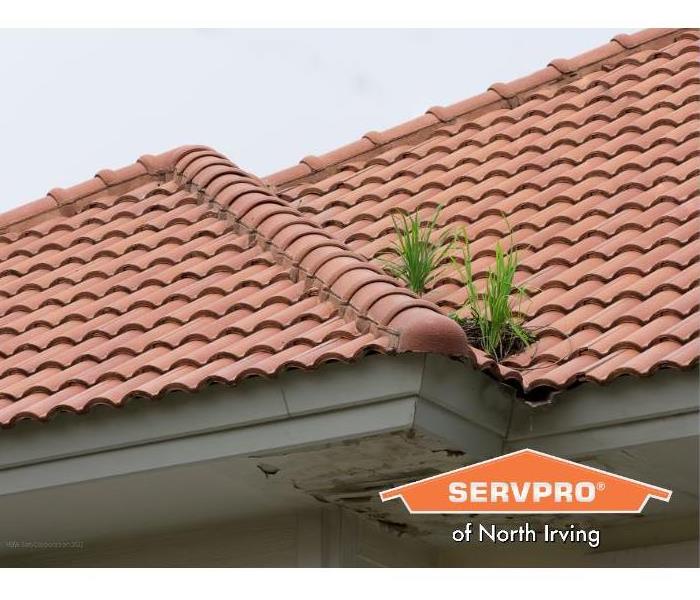 If you suspect that there is water damage lurking in areas around your household, we have some suggestions on where to look so you get to the damage.
If you suspect that there is water damage lurking in areas around your household, we have some suggestions on where to look so you get to the damage.
There may be hints that there could be water damage in your home. One of the clues is a musty or moldy smell in the home. If you suspect that there is water damage lurking in areas around your household, we have some suggestions on where to look so you can intervene before it gets worse.
Exterior Water Damage
Look at the frames of the windows and doors. Dew accumulation leads to deterioration on the surface between the materials, such as bubbles, peeling paint, or warping. Also, you might find signs of moisture affecting the framing of the windows where pieces start to degrade and break away.
With siding, check where the panels meet for flaws where water can sneak in. Similarly, the water can pass through protective siding through cracks. If your exterior is wooden, look for signs of rot.
Next, we look to the roof. Are your gutters clear of debris and intact to control water runoff? Are there any missing shingles or depressions along the roof’s surface? Is the flashing in good shape? For tiled roofing, look for broken or loosened tiles. Just one flawed shingle, tile or piece of flashing is a vulnerable spot for water to creep in.
Interior Water Damage
Check around the window framing for signs of warping or peeling of paint. Do you see water stains on the walls or the ceiling? These are warning signs of water problems.
Next, check where water is used most: appliances, bathtubs, showers, and sinks.
- For appliances, check under the dishwasher, and behind the clothes washer.
- For sinks, check under the sink and look for warping in the surrounding countertop.
- For toilets (especially if it wobbles) look for warping and mold growth behind the toilet and around the base where there may be floor damage.
- For tubs and showers, look for damage around plumbing connections. If any caulk is missing around the tub, check the tub surround. Look up at the walls surrounding the shower. There may be warped drywall or mold and mildew forming from a lack of ventilation.
Attic or Basement
It’s easy to miss the progression of water damage in an attic or basement when you seldom enter these. Up in the attic, there may be damp or moist areas or watermarks on the surface above. Does it feel humid up there during the summer? Moisture is getting in somehow.
In the basement, water can leak from plumbing or enter via hydrostatic pressure around the perimeter of the house. Look for damage around the windows and window wells along with swelling and water stains on the basement walls.
Check any plumbing that may be running water to the basement (bathroom or laundry room). Also, check for puddles around the sump pump or other draining apparatuses. If the basement isn’t draining properly, this leads to water damage.
Call SERVPRO of Richardson for Water Damage Restoration Services
SERVPRO’s teams are trained on advanced moisture detection techniques and specialized equipment. We remove water-damaged materials, extract as much water and moisture as possible, and use thorough drying techniques.
We work to solve the water damage problem at its source and eradicate all traces of moisture to prevent toxic mold growth. If you have recurring water damage problems or don’t have time to address these issues, give SERVPRO a call at (972) 690-1414 for a free estimate.
Richardson Water Damage Restoration for Winter Storm Damages
3/12/2021 (Permalink)
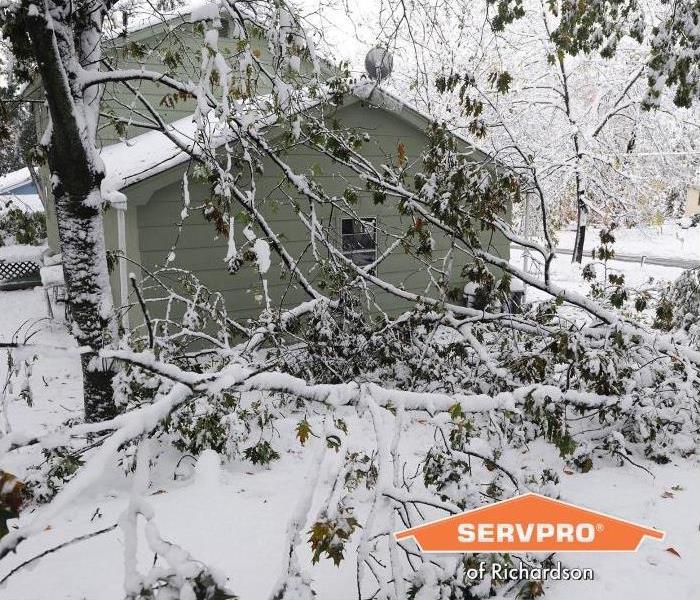 If you've experienced water damage due to a winter storm, contact our North Dallas SERVPRO location for professional water damage restoration services
If you've experienced water damage due to a winter storm, contact our North Dallas SERVPRO location for professional water damage restoration services
As we’ve seen in 2021, extreme winter weather takes a toll on Texas. We cope with car crashes, empty shelves at the grocery store, downed powerlines, and everything is frozen - pipes included.
While we wish our neighbors could spend the winter blast sipping some cocoa by the fire, many property owners find themselves scrambling to handle damage from fallen trees, frozen plumbing problems, and sometimes even a housefire.
No matter what winter weather does to damage your property, we’re prepared to come to your aid and make it “Like it never even happened.”
SERVPRO is Winter Ready
One of the most common problems property owners encounter is water damage from indoor plumbing failure or external problems like roof damage.
Unfortunately, water damage is usually something you can’t just let dry out. The longer you wait to address water damage, the more likely it is that secondary damage happens such as mold growth. Secondary damage easily adds on more repair costs.
Waiting too long to address water damage might also impact an insurance claim. If an insurance company determines that secondary damage could have been prevented, some or all of the claim could be declined.
Where to Check for Damage After a Winter Storm
Because unaddressed damage leads to more costly repairs, it’s wise to account for all damage done to the property. Below is a list of what you should check for after a winter storm.
- Fence damage - Fallen trees can ruin the fence or other property structures.
- Roof damage - Problems like ice dams lead to roof damage. Look for missing shingles, flaws in the flashing, or depressions on the roof surface. Also, check the spouting and downspouts.
- Siding - Are panels loose or cracked?
- Windows and doors - Are there any signs of leaks?
- Basement or crawl space - Has water collected in these out-of-the-way areas?
- Sheetrock and subfloor - Extreme flooding tends to penetrate deep into the construction.
Now is the Time to Call SERVPRO of Richardson
Don’t wait for secondary damage to happen. The longer water sits, the more construction materials will rot and mold will flourish. Timing is everything, so we are, “Faster to any size disaster.” With 24/7 service (even weekends and holidays), we are always ready to get started on Richardson water damage restoration tasks.
What you get with our comprehensive water damage services:
- Single point of contact - just one call to make.
- Work with insurance on your behalf.
- A team of specialists who act quickly and have advanced training in drying techniques and mold detection.
- Thorough inspection and damage assessment.
- Address the source of the water damage with needed repairs.
- High-powered water extraction equipment.
- Thorough drying and moisture elimination.
- Mold testing and application of mold mitigation measures.
- Cleanup and handling of contaminated materials.
- Professional-grade cleaners and deodorizers.
- Carpet and flooring cleaning.
- Repair or replacement of construction materials (including roof repairs).
- Furniture recovery.
- Textile, clothing, and other soft good restoration in the Esporta Wash System.
- Electronics recovery.
- Appliance repairs.
- Document and photo recovery.
- Addressing risks of future damage.
SERVPRO doesn’t wait until the day before the first freeze to prepare for winter weather. We’ve been ready all year. Call us now at (972) 690-1414.
Signs You Need a Sump Pump Replacement
12/21/2020 (Permalink)
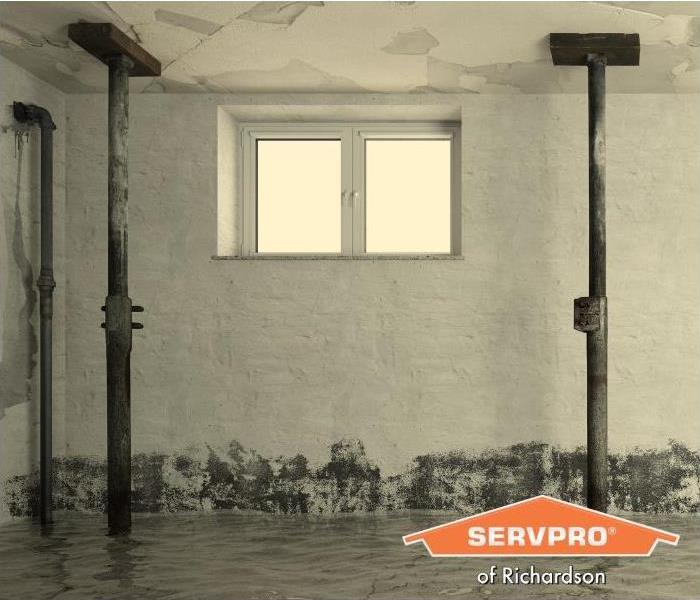 If your sump pump fails and you end up with water damage, contact SERVPRO of Richardson for professional water damage restoration services.
If your sump pump fails and you end up with water damage, contact SERVPRO of Richardson for professional water damage restoration services.
If you have a basement, chances are you also have a sump pump, and this is a very good thing. Sump pumps prevent water and moisture damage to your basement and foundation by keeping the area dry.
How long has the sump pump been installed in your basement? If it’s been several years, chances are you will need a sump pump replacement soon, as this is the sump pump life expectancy.
Water collection in your basement can be destructive, so a homeowner must maintain the sump pump. You’ll know it’s time for a sump pump replacement when you start to notice sump pump problems.
As the mold remediation and water damage restoration experts in Richardson, SERVPRO understands how a property owner benefits from the constant operation of sump pumps. To keep your basement in tip-top shape, we recommend you monitor for signs that indicate you need a sump pump replacement.
How Many Years Does a Sump Pump Last?
A sump pump life expectancy is about 10 years. How often to replace a sump pump might be affected by factors that shorten the average life of a sump pump. This happens when a sump pump is overworked, barely used, or if it experiences electrical issues.
Common Signs Your Sump Pump Is Having Problems
The best time for a sump pump replacement is before it fails. The point of having a sump pump is to keep your basement and its walls dry, and once your basement starts to take on water it’s too late for prevention.
Below are three telltale signs that a sump pump replacement may be an immediate need.
Problem Sign #1: Sump Pump is Constantly Running & Is Noisy
When the pump is frequently running but there is no water to extract, there is the risk of a burned-out motor. The wastewater helps cool down the sump pump motor so it doesn’t overheat. This issue should be addressed as soon as possible because of how likely it is that the motor will fail.
Other reasons that sump pumps run constantly are:
- The sump pump is not the right size for the basement.
- The sump pump switch is stuck and cannot turn off.
- Check valve failure
Noises are another sign that it may be time for a sump pump replacement. You might hear gurgling, rattling, grinding, or thuds when the pump is malfunctioning.
When the sump pump is running all the time or is noisy, this problem may be resolved with a motor repair or replacement rather than a whole pump replacement.
Problem Sign #2: Sump Pump is Clogged
Another cause for sump pump failure is when the channels get clogged up. Only water should be entering the sump pump. When other things get inside, this clogs the pump. A sump pump without a lid is vulnerable to clogs. You need an airtight lid to keep out dirt, debris, and other intrusions that would jam sump pump switches.
Another common cause of sump pump clogs is a thick orange slime called bacterial iron. This goo forms around wells and groundwater sources. A chlorine shock can prevent this from accumulating and causing a clog.
Problem Sign #3 Sump Pump Cycle is Erratic
Sporadic activity, shutting off during the cycle, or taking a while to empty are all symptoms of an erratic pump cycle. Reasons for this malfunction are check valve failure, the float valve is too low, faulty wiring, or a short circuit respectively. A sump pump that takes too long to empty isn’t prepared for a flooding emergency.
Troubleshooting an erratic sump pump includes inspecting the check valve or the float valve, examining the wiring, and checking for installation errors. It’s also possible that the pump isn’t compatible with the basement situation, and so a sump pump replacement is needed.
Is a Sump Pump Easy to Replace?
Compared to what is involved in carving out housing for the sump pump, replacing the sump pump is easy. With the pit already in place, the hard part is already done.
While a sump pump replacement qualifies as a DIY project, you should have a fair amount of home improvement experience and a firm grasp of what all is involved with a well-functioning sump pump.
How to Replace a Sump Pump
Depending on the issue, installing sump pump replacement can be a time-consuming project. Below are the basic steps of this procedure.
- Cut off electricity to the sump pump then remove the cover to unplug the old sump pump.
- Detach the sump pump from the discharge line. Then cut a length of PVC pipe (1 ¼ - 1 ½ inch) for the new sump pump. It’s better to cut it a bit longer than too short (as you can always trim it down).
- Find the discharge outlet on the new sump and join it with the PVC pipe using a male adapter. Make this connection watertight by using purple primer and PVC glue.
- After the sealants have had enough time to dry, lower the new pump into the sump pump pit. Don’t let the pump lean against the side of the basement, and make sure that the wires do not become tangled. Also, allow clearance between the float switch or back-up pump.
- Check to make sure the pump is level. The pump should be flush against the concrete floor. Use a level to check for stability. Shims can be put into place to make adjustments.
- Orient the float switch. It needs to be positioned where it can remain unobstructed and at the appropriate height. If it’s too low, the pump will run too much, and if it’s too high it won’t start at the right time.
- Connect the new discharge line to the existing pipe. To avoid water reentering the basement after it’s been pumped, put the check valve back in place or use a union connector to connect the pipes.
- Power the sump pump for testing. Fill a utility bucket with five gallons of water and pour it so it will enter the pump. If it can handle this influx of water, it’s ready for a possible flood. Monitor to make sure that the water is draining to the appropriate place.
If a sump pump stops working during a flooding event, you’d need to act fast with alternative methods. To monitor your basement for a flooding problem, you should consider installing a sump pump water alarm. Once the water gets to a certain level, this trips an audible alarm.
Do You Need a Plumber to Replace a Sump Pump?
People who are sure they have the right sump pump for their basement and feel comfortable with the skills level required for a sump pump replacement should be able to install it with no problem.
However, some property owners are unsure of what sump pump to purchase, aren’t sure they can do it properly, or don’t have the right tools to complete the sump pump replacement project.
While hiring a plumber can easily double the cost of a sump pump replacement, in some cases, this is the only way to replace it. Keep in mind that plumbers may not be able to do the necessary waterproofing needed around the sump pump. You may need to hire a separate handyman for this.
How Much Does it Cost to Replace a Sump Pump?
Installing your own sump pump usually costs a few hundred dollars ($150-$300). This includes the cost of the pump itself plus the other supplies needed (PVC pipe, primer, glue, adapters, etc.)
Project costs also depend on what kind of sump pump you need. Submersible pumps are more expensive (between $100 - $400) than pedestal pumps (between $58 - $170).
You can expect sump pump replacement costs to at least double if you hire professionals to do the removal and installation.
SERVPRO Richardson is Ready to Help
Just like any room of a home or business, the basement should stay dry. Having a sump pump in place guards the basement against excess water that causes damage, including toxic mold growth.
Unlike a basement, a sump pump isn’t made to last forever. You can expect to replace the sump pump every 7-10 years.
If your sump pump fails, SERVPRO is always available to provide water damage restoration. We have experience with flooding scenarios of all kinds, including Richardson sewage cleanup.
If your basement floods or the walls show signs of extensive water damage, don’t delay. The sooner you act, the more damage can be avoided. Call us at (972) 690-1414. We’re available 24/7 and faster to any size disaster.
How to Deal With Ceiling Water Damage From a Burst Pipe
10/26/2020 (Permalink)
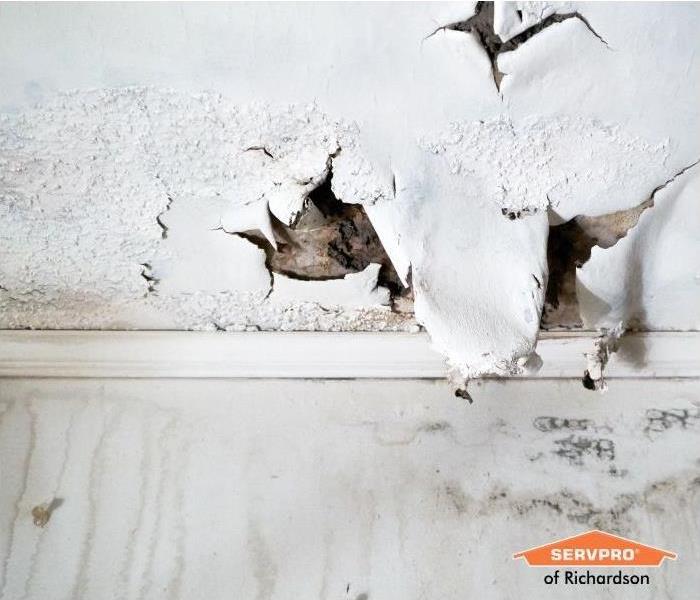 Contact SERVPRO in Richardson at the first signs of water damage on your ceiling. We provide professional water damage restoration in North Dallas.
Contact SERVPRO in Richardson at the first signs of water damage on your ceiling. We provide professional water damage restoration in North Dallas.
Thanks to ceilings, we don’t have to see wiring and pipes every day, but when a once smooth and dry facade becomes stained or drips, this is a sign that something is very wrong.
When you have appliances or bathrooms on the floor above, plumbing runs upward to supply water for these functions. Problems with either the pipes or the items they attach to can create a water emergency that damages anything below it, the ceiling included.
The good news is that you’ve now caught the problem, and can take action before it gets worse. As your Richardson SERVPRO, we can’t stress enough how important it is to react promptly to water damage. We’ll share how to spot water ceiling water damage and what to do to fix a leaking ceiling.
Signs of Ceiling Water Damage From a Burst Pipe
As long as water continues to leak from a broken pipe, continuous damage will occur. The sooner you can recognize signs of ceiling water damage to the ceiling, the more likely you are to successfully prevent extensive damage.
Rings of stains are made when water seeps through ceiling material and mixes with its composite fibers. Ceiling stains are a common indication of a leak (and might even be the first sign), but there are other things to look for that could mean you have an emerging leak problem.
Yellow or Brown Watermarks
So what does a ceiling water stain look like? These appear as watermarks that are typically yellowish-brown or “rusty” brown.
Ceiling marks don’t always mean that there is a current water leak. Sometimes they are remnants of water issues that have been resolved a while back (perhaps by the previous owners).
Even if the damage isn’t new, it’s still worth investigating it to find the source of the problem. The more rings that appear and the more they spread across the ceiling, the more likely it is that there is an ongoing problem.
Swollen or Warped Ceiling
Ceilings are made to be flat and even. Swelling in ceiling material can come in the form of a slight bend or more curvy droop. Swelling on your body is a sign of a problem, and it’s the same with ceilings.
Rings of stains are made when water seeps through ceiling material to mix with and activate the composite fibers. Ceiling stains are a common indication of a leak (and might be the first sign), but there are other things to look for that signals for an emerging water leak.
Mold Odor and Stains
Mold loves to be surrounded by cellulose material and moisture - soggy ceilings provide both. You’ll notice mold growth by its musty smell coupled with its dark spotting.
Apart from the ugly and splotchy pattern mold makes on your ceiling, mold can also potentially make the living environment unhealthy.
You might go days without looking at your ceilings. If something abnormal catches your eye, it’s worth it to find out if there’s a water leak behind it. If one area alerts you to water damage, this is a good time to check all of your ceilings for problems.
How to Deal With Ceiling Water Damage
Once you’ve determined that your ceilings are damp from water leaks, It’s time to get an action plan together.
1. Prepare the Area Around Ceiling Damage
For this step, you will ready the area for falling water. This step is especially important for swelling, sweating, or dripping ceilings. Move anything out of the way that you wouldn’t want to get wet.
To catch water that reaches the ground, place a tarp or towels on the floor below. Have on standby a bucket and piercing tool (like an awl or screwdriver).
Set up a ladder under the affected area and carefully climb up the ladder while bringing a bucket and piercing tool with you.
Determine the center of the damage. Place the bucket under the center to catch the water (setting the bucket on the top of the ladder may help so you don’t lose your balance). Carefully poke a hole in the center. If water starts to flow through the hole, allow it to collect in the bucket until it stops.
2. Track Down the Source of Water Damage
If water releases from poking a hole in the ceiling, this confirms that there are recent and possibly ongoing water issues causing the saturation.
Fixing the ceiling but not the source of the water damage means an endless cycle of repairs. The source of the ceiling water damage must be addressed to stop it from continuing.
Investigation Methods
- Cut out a piece of the ceiling and use a flashlight to look and listen for drips from pipes.
- Scope out the area directly above the leak. This could be the crawlspace or an upstairs room with running water (such as a bathroom or utility room). Look for any plumbing issues in these spaces. Possible causes include leaks in the drain system, faults in the supply line, or broken caulking.
Keep in mind that water leak trickles can cling to and travel along pipes. When this occurs, the source of the damage may not be directly lined up with the site of the ceiling damage.
Once you find the source of the leak, determine if it’s something you can fix with confidence. If not, it’s time to call in the professionals.
3. Dry the Affected Area
Wetness cannot remain. The affected areas must be totally dried to avoid rotting to construction and mold growth. Here’s how to dry ceiling water damage.
High-powered fans and a desiccant dehumidifier will speed up the drying process. This type of equipment can be rented.
For widespread damage, the ceiling material may need to be cut away substantially so that airflow can reach and dry the construction behind it.
Place the drying equipment as close to the affected area as possible. This includes the ceiling material and any wooden structures above it (such as joists). Be sure to empty the dehumidifier as it fills.
The drying process can take up to a full day to complete. Surfaces that appear to be dry may still be harboring moisture. A moisture meter will confirm if the area is actually dry enough.
Don’t have all this equipment on hand? SERVPRO does. We’ll bring the best tools in the industry to ensure that the affected areas are completely dry so that mold and rot won’t set in.
4. Repair Water Damaged Ceiling
Once the leaks have been resolved and the areas are dried, we move on to repairing the water damaged ceiling.
The appropriate remedy depends on the size and nature of the damage. A modest amount of stains can be bleached, sanded down, and painted over with products intended for stains (such as an oil-based undercoat and stain-sealant paint). If you made a hole to check for water build-up, patch that up with plaster or drywall mud before you paint.
In cases where the damage is widespread and sections had to be cut out, you’ll need to replace the drywall or plaster. Retexturize and paint as needed to make it match the rest of the ceiling.
Reach Out to SERVPRO Richardson for Water Damage Restoration
It can be a challenge to fix a ceiling, especially if you have physical limitations or the problem is beyond reach. When you get to a point where you’re not confident you can handle the repair nor locate the cause of the damage, SERVPRO is here to help you.
For decades, we’ve been a trusted provider for Richardson water damage restoration. With our 24/7 emergency dispatch, we are faster to any size disaster in Richardson, Texas.
We’ll come out to your property ASAP to assess the damage, find the source of the water damage, and complete the recovery. In no time, your ceiling will be as good as new!
Don’t delay! The longer a ceiling is exposed to water and moisture, the more likely it is to break down or develop toxic mold growth. Call us any time at (972) 690-1414 with any questions about pipe leaks, water damage, or to request free pricing!
Water Damage Restoration and Water Cleanup Company in Richardson
9/22/2020 (Permalink)
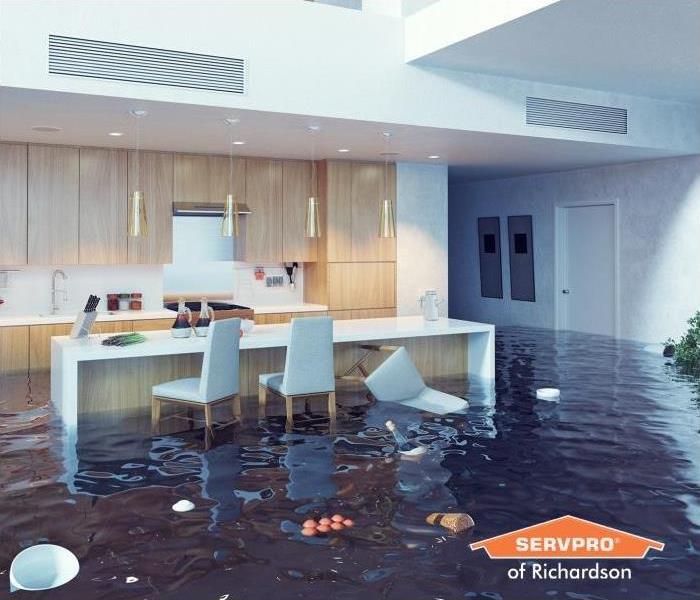 Do you have water damage on your property? Contact SERVPRO of Richardson right away! We're your experienced North Dallas water cleanup company.
Do you have water damage on your property? Contact SERVPRO of Richardson right away! We're your experienced North Dallas water cleanup company.
Water emergencies happen fast and oftentimes with little to no warning. Water is needed to live, but it can easily ruin property and possessions. And when gallons of water come pouring in, it can be an overwhelming mess!
The more extensive the water damage, the harder it is to clean up and remediate. In most cases, you can’t afford to delay as water damage leads to damaging mold growth.
Cleaning up after a flood isn’t something you can do alone. SERVPROs in North Dallas are faster to any size disaster! Our water cleanup company is available around the clock to dispatch immediately to residential and commercial properties and begin the recovery services process.
Causes of and Common Types of Water Damage
Water can and will end up where it doesn’t belong. These are the common scenarios for water damage to Richardson residential and commercial properties.
- Flooding and severe storm damage.
- Overflow from rivers, streams, draining systems, etc.
- Sewage or septic backup.
- Water from firefighting.
- Basement flooding.
- Water leaks from broken appliances (water heaters, washing machine, or dishwasher overflow).
- Water leaks from broken plumbing or pipes and hoses (pipes bursting during the winter).
- Overflow from toilets, bathtubs, or sinks.
- A leaky roof or foundation cracks.
- Moisture accumulation behind walls, in the carpet, in the HVAC system, etc.
SERVPRO of North Dallas has encountered water damage repair of all kinds. Our experience prepares us to come up with the best plan to tackle the job right away.
Do I Need Professional Water Repair and Restoration Services?
While some damage is obvious (such as ruined photos and drywall), other kinds of water damage are not so obvious. A trained eye knows what to look for and how to assess risk with both experience and the help of technologically advanced equipment.
With services from a professional water cleanup company like SERVPRO, you not only get a complete restoration, but you’ll also have prevention measures fully in place.
The longer water damage goes unaddressed the more your property is at risk for further damage. Help from the professionals is here for you to get it taken care of now!
Why SERVPRO Over Other Water Cleanup Companies?
SERVPRO didn’t become the #1 brand for professional water damage companies by accident. Our commitment to high standards is how we can say with confidence that we make it "Like it never even happened."
Since 1986, SERVPRO has been on the scene to assist with water damage recovery to residential or commercial properties. Our extensive experience and professional equipment have us prepared for any job - small or huge!
Highly Trained Water and Flood Damage Specialists
SERVPRO has a solid team with experts specialized in various capacities.
- IICRC certified - The Institute of Inspection Cleaning and Restoration Certification sets the standards for restoration and cleaning. Our technicians are up to date on the latest water restoration certifications.
- Psychrometric training - Our technicians understand, in detail, the science of moisture and humidity. This empowers them to be more precise in moisture management.
Professionals On Hand for Any Restoration Services
Not only do we have world-class technicians on staff who are up to date on the latest industry trends and techniques, but they are also on call around the clock.
SERVPRO is prepared to come out to your residential or commercial property whenever you need us - even on holidays or in the middle of the night.
State of the Art Water Restoration Equipment
For every water damage job site, our goal is to bring the property back to preloss condition and remove any moisture that might lead to mold growth.
In order to do a complete and thorough water damage restoration, we are equipped with the best tools in the industry.
Moisture Detection and Measurement
Our technicians use sensitive moisture detectors, meters, and even infrared cameras to locate, measure, and monitor moisture. This allows us to assess exactly how extensive the water damage is - even through walls and floors.
We monitor the moisture throughout the restoration process to ensure that the property is fully recovered.
Water Extraction
A home or basement may end up with gallons of water. Our truck-mounted or submersible gas-powered pumps efficiently remove water from flooded spaces.
Drying
Once the water has been removed, the drying process can begin. Surfaces may appear dry but are still likely to be damp.
Our high-speed air movers and industrial-grade dehumidifiers efficiently remove damaging moisture from the air, ceiling, walls, and floors of your property. Thorough drying prevents further damage such as warping and wood rot- and most importantly, to prevent mold growth.
Odor Removal and Deodorization
Water damage often leaves an odor behind. Our air scrubbers remove airborne particles and contaminants to restore air quality. We also have thermal foggers and deodorizers on hand to remove any remaining smells.
Sanitizing Agents, Germicides, and Antimicrobial Treatments
We are Richardson’s mold-fighting team. Our professional-grade cleaning agents stop the growth of any remaining bacteria, fungi, mildew, and other harmful microorganisms.
Our Unmatched Water Damage Restoration Process
No two Richardson flood damage restoration residential or commercial scenarios are identical, but our extensive experience allows us to come up with the best action plan for any variables.
SERVPRO is the water cleanup company with the professional expertise needed to swiftly restore your property to preloss condition. Our scientific approach to water extraction and cleanup involves monitoring and documenting the drying process from beginning to end.
While our plans are tailored to your individual needs, our 6-step process applies to most scenarios. Each step is determined according to the specific restoration needs for your property damage including contamination levels.
Step 1: Emergency Contact
Step 2: Inspection and Damage Assessment
Step 3: Water Removal/Water Extraction
Step 4: Drying and Dehumidification
Step 5: Cleaning and Repair
Step 6: Restoration
SERVPRO’s thorough process is aimed toward the prevention of mold and bacteria growth or the spread of other toxic microorganisms that could cause further harm. These organisms could create a health hazard and our goal is to completely mitigate this issue (including carpet cleaning services in Richardson).
Water-Related Resources
Getting an action plan together is the first step toward recovery. Here are some resources with the information and tips you need to get everything under control:
And from our SERVPRO library:
No matter how much we plan, water damage can still and will happen. You are not alone. SERVPRO is here to answer any questions you have or offer tips about how to recover from water or storm damage as well as provide top-notch water damage restoration services.
SERVPRO is Here and Ready to Serve Your Restoration Needs
Properties are designed to keep water out, but sometimes it still ends up where it does not belong and creates damage. Whether water comes from the outside in or from the inside, this needs to be addressed right away as mold problems are soon to follow.
While you can’t pretend "Like it never even happened," we make it "Like it never even happened." SERVPRO’s Richardson water damage restoration experts are here to get started on water damage recovery right away so it doesn’t get worse.
Call on SERVPRO to get the situation under control and back to normal in no time. We have the professional equipment and extensive experience needed for a full recovery. Call us at (972) 690-1414 anytime 24/7! We also offer free estimates.
How Long Does it Take for Wood to Rot from Water in Richardson?
9/2/2020 (Permalink)
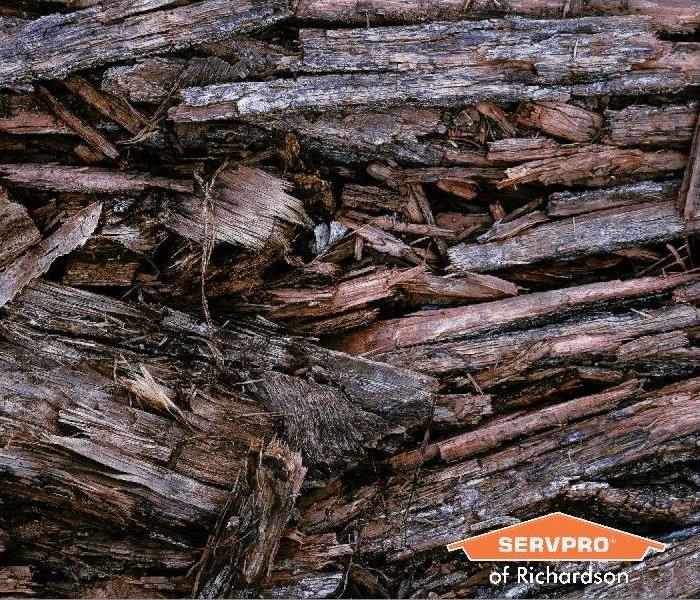 If you've experienced flooding in your home, contact the water damage restoration experts at SERVPRO of Richardson.
If you've experienced flooding in your home, contact the water damage restoration experts at SERVPRO of Richardson.
Has your home been flooded from a plumbing mishap or storm? Storms and floods, water leaks, and plumbing defects in Richardson can cause the wood in your house to rot. So, how long does it take for wood to rot from water? It depends on several factors. If the decay goes unnoticed or isn’t addressed quickly, wood can rot and be destroyed in just a few short years.
What Causes Wood to Rot from Water?
Water damage causes interior wood wet rot. Leaking roofs, burst pipes, or plumbing defects allow for water ingress into the building’s structure. Wood frames, studs, subfloors, and other wooden parts of the house are at risk of rotting away. When wood is exposed to water over a long period, wet rot takes hold.
Does Wood Rot Spread?
For wet rot to occur in wood, the wood must contain a 30% moisture content over a long period. Fortunately, wet wood rot won’t spread. But if the moisture problem isn’t remediated wood rot will continue to eat away at the wood until it’s completely decayed. Taking care of the moisture content with a dehumidifier, and halting the water ingress will halt wet wood rot. But dry rot is another story.
What is Dry Rot?
Dry rot is a form of wood decay like wet rot. But while water is the direct cause of wet rot, fungi cause dry rot. Dry rot weakens the wood, makes it brittle, and gives the wood a blocky appearance. Dry rotted wood will crumble and splinter when you touch it.
While moisture doesn't directly cause dry rot, it does indirectly. High humidity feeds the fungus that causes dry rot, so remediating water damage is the key to preventing this type of wood decay. Unfortunately, dry rot will spread if left unaddressed.
Dry Rot Treatment
How can you fix dry rot? Dry rot treatment includes using epoxy, commercial antifreeze, and copper components to strengthen the wood and destroy the fungus that’s causing the dry rot. Addressing moisture issues will also prevent dry rot from taking hold.
Wood Rot: A Takeaway
If your home has experienced water damage, wet and dry rot can occur and severely compromise your house's structural integrity. At SERVPRO of Richardson, our water damage restoration experts are standing by to assist. Contact us today to get help for your water damaged property as soon as possible.
How to Fix Water Damage on Baseboards in Your Richardson Home
8/5/2020 (Permalink)
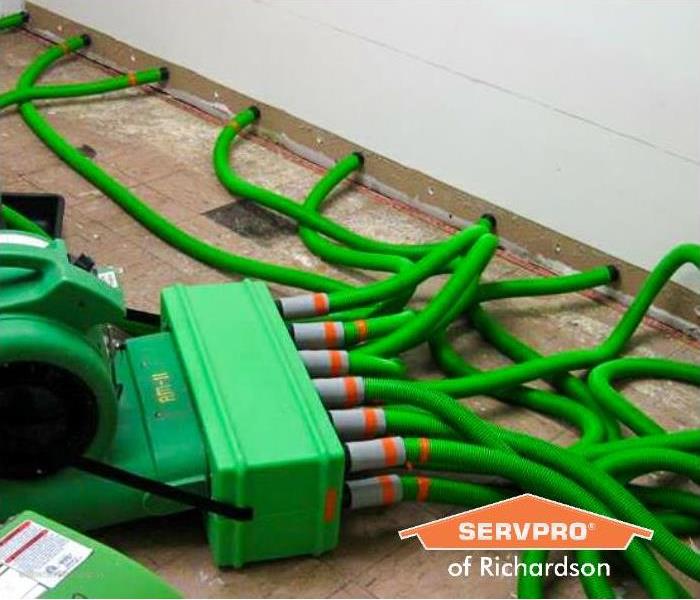 If you notice signs of water damage on your baseboards, contact our Richardson SERVPRO location right away.
If you notice signs of water damage on your baseboards, contact our Richardson SERVPRO location right away.
Are your baseboards looking a bit odd? As you sweep the floor or do a deep clean, you might stumble upon water damage on baseboards.
Perhaps this is the first sign of interior water damage, or you’ve dealt with a recent water damage problem that caused wet baseboards. At any rate, baseboards that show signs of water damage ought to be addressed to prevent mold growth and rot.
SERVPRO is here to provide property maintenance guidance and water damage services in Richardson, Texas. In this article, we’ll get to the bottom of water damage on baseboards.
Signs of Water Damage on Baseboards
A baseboard with severe swelling or bending is a telltale sign of water damage. More understated clues are slight bowing, water stains, the start of mold growth, or peeling paint.
Water that soaks wood greatly compromises its integrity. Baseboards that have been well-soaked with water will show signs of damage.
How to Fix Baseboards with Water Damage
Baseboards are for interior aesthetics. They finish off the wall. So, repairing baseboards restores the look to keep a damaged one from sticking out like a sore thumb.
Fixing baseboards also allows you to investigate further damage to the wall. If mold has started to sprout behind the baseboard or water is leaking under the baseboard, you’ll be able to uncover potential issues during this process.
It’s helpful to have plenty of light for this project. Use a headlamp for extra light, if needed. Also wear safety goggles and PPE (personal protective equipment) should there be any black mold.
1. Loosen Wet Baseboards
Removing the baseboards allows you to observe the extent of the damage and determine how much repair is needed.
To loosen, use a utility knife along the caulk seal to break the hold between the trim and the wall. Be careful not to make the cuts deep as this could damage the drywall.
2. Pry Off the Baseboard
Now that the baseboard is loose, remove it from the wall. Gently separate the trim from the drywall in sections. As you remove the baseboards, keep the finishing nails with these pieces.
Once all the baseboards have been separated from the drywall, inspect for other signs of water damage like warping, stains, mold, sogginess, etc.
3. Clean Up Drywall
This step prepares the baseboard to be reattached to the wall. For the best results, the wall should be as smooth as can be. This allows a nice flush contact between the trim and the drywall with a better seal.
Peel off any bumps from glue or caulk. Use sandpaper to make the surface clean and even.
Use the utility knife to remove old glue and caulk residue from the wall. A smooth surface ensures a better seal when you attach the new baseboard. Finish off rough spots with a drywall sander.
4. Allow Area Under Drywall to Dry
You may discover that the drywall underneath is still somewhat damp. If so, you’ll need to allow the wall and subfloor to dry out completely. If the drywall or subfloor is soaked or warped, it should probably be replaced as well.
The idea is to reattach baseboards to a wall that won’t grow mold or rot. Hopefully, the wall is already dry or mostly dry so you won’t have to replace it.
This is the time to address any sources of water damage. If it’s soaked and you don’t know why you’ll need to determine the cause. If the issue that caused the water damage isn’t fixed, the wall and baseboards will just incur damage all over again and need another replacement.
5. Replace With New Baseboards
Measure the length of where the baseboard trim was removed. This length with an allowance of a few feet is what you’ll need to purchase. The extra length will make up for any errors or miscalculations.
Bring some of the old wood with you to the home improvement store to match the trim. If the original trim was MDF, you might consider upgrading to a wooden trim. MDF is more vulnerable to water damage as it is more porous.
While you are at the hardware store, get a match for the paint color of the original trim. Finding the paint color that matches your trim preserves the continuity of the room’s look.
We recommend that you prime and paint the trim before cutting and reattaching it to the wall.
6. Miter for a Smooth Fit
Miter box cuts at a precise 45 angle for the tail ends of the baseboards. You’ll want the right flush for the trim’s connections at corners and with those pieces still attached.
7. Secure Boards in Place
You’ll need caulk and finishing nails for this step. It is recommended to use silicone caulk for bathroom and kitchen projects. You can either use new finishing nails or reuse nails from the old pieces by removing them.
Apply caulk to the replacement trim so it stays in place. Ensure a good fit with both the trim still attached and the edges (or corners). Once everything looks right, secure the baseboard pieces with the finishing nails.
Apply caulk to the top of the trim for a finishing seal between the baseboard and the wall.
Hopefully, it’s a simple repair with no unsolved contributing water issues. If you can’t figure out what is causing or caused the water damage in the first place, SERVPRO of Richardson is here to help.
Restoration Services in Richardson, TX
SERVPRO is “faster to any size disaster”! Our team of extensively trained water damage restoration technicians is on call 24/7 to respond at a moment’s notice. We arrive completely prepared to start the water damage restoration process so that you can get back to life as usual as soon as possible.
We use the best equipment and technology in the restoration industry to ensure that the property is completely clean, totally sanitized, free of toxic mold, odor-free, and thoroughly dry.
We do an inspection to identify the cause of the water damage to prevent it from happening again.
Our Richardson restoration services include:
Reach Out to SERVPRO Richardson for Water Damage Restoration
Baseboards are for aesthetic purposes, so we tend to determine if damage should be addressed based on how bad they look. However, water damage on baseboards should be addressed whether they look bad or not.
Identifying the root cause is how you prevent having to do the baseboard repair process all over again. We’re here to answer any water damage questions you have and would be glad to send our experts out to help you figure out the source of water damage issues. We’re here to answer the call 24/7 at (972) 690-1414 or fill out our quick and easy contact form anytime!
Water Damage Restoration Service in Richardson, TX
6/16/2020 (Permalink)
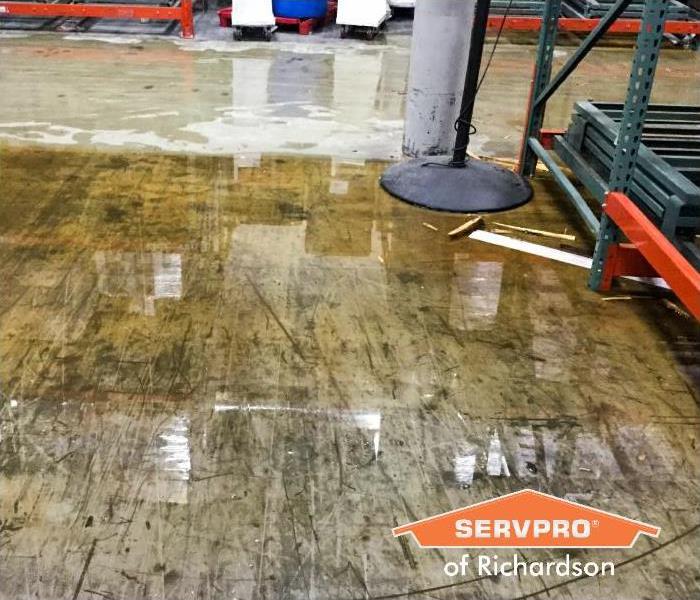 Water Damage Restoration in Richardson
Water Damage Restoration in Richardson
Water is wonderful - until it makes its way into a house or commercial building. Everything is designed and installed to prevent water from getting where it doesn’t belong, but sometimes plumbing will fault or sewers back up. We rely on quality construction to keep spaces dry, but when this fails, water damage happens.
Recovering from water damage can be a major ordeal but cleaning it up not something you have to do alone. From structural problems to natural disasters, SERVPRO of Richardson is here to help in any water emergency.
Professional Water Damage Restoration in Richardson, TX
SERVPRO of Richardson is a locally owned and operated water restoration company. For 30 years we’ve provided home and commercial restoration services. Our decades of experience make us your water damage restoration experts!
Who we are:
- We live up to our motto: “Faster to Any Size Disaster.”
- 24-hour emergency service, 7 days a week.
- A trusted leader in the Water Restoration Industry.
- A staff of highly trained Water Restoration Technicians.
- Provider of advanced water inspection, extraction, and drying equipment.
Reach out to us at any time for prompt and complete flood damage cleanup and water removal services!
What Can Cause Water Damage?
Water damage occurs when too much water comes into contact with items that are designed for a dry environment. Basement flooding is not as common in this part of the country, but below are some possible scenarios that may require water damage restoration for homes and commercial properties in Richardson.
- Storm or flood damage caused by severe weather.
- Flooding from the use of firefighter hoses.
- Gutter overflow.
- The entry of water into attics and crawl spaces.
- A sewage backup enters a home or commercial space.
- A pipe leaks or bursts.
- Problems with the plumbing system.
- Sinks, bathtubs, or toilets overflow.
- Water-related HVAC system problems.
- Plumbing or appliances leak water.
Water mitigation measures can be taken to prevent many of the above from becoming a problem. But when best-laid water damage prevention plans don’t hold up, this creates a need for water damage restoration.
Water damage services are the most significant part of our cleaning business. For this reason, we have our team of technicians on-call and available to dispatch to the property in your moment of need. We arrive at the scene prepared to begin the water damage restoration process immediately. Being consistent and reliable has made us the leader in the cleaning and restoration industry.
What Are Signs of Water Damage?
When water penetrates through building materials, it leaves clues behind. Here are some telltale signs that there has been water damage to your property.
- Standing water - The room appears to be flooded with several inches of water, or there are pools and puddles of water indoors.
- Spots or discoloration - There are dark or discolored areas on the floors, ceilings, walls, or inside cabinets or closets. These might also appear around pipes, sinks, toilets, etc. Paint or drywall that is peeling or cracking could also be a sign of water damage.
- Squishy or squeaky floor.
- Unusual sounds of rushing water.
- The appearance of mold.
- The smell of mildew - The room feels musty or humid.
- The smell of sewage inside the building or home.
- An unexpected increase in the water bill.
Any of the above conditions should be addressed immediately with repairs or water damage restoration solutions.
Our Water Damage Restoration Process in Richardson
At SERVPRO of Richardson, we are the water damage restoration experts. Because each situation we come into contact with is unique, our cleaning approach is not one size fits all. We customize client cleaning plans according to the particular needs of each restoration.
Sometimes the extent of the water damage is more than what is seen at first glance, so we do an in-depth inspection to make sure we uncover all the issues. Being proactive prevents further damage and potential health risks.
To protect your health and property, water and sewage must be completely extracted. The area must be completely cleaned, dried, and disinfected - all with proper ventilation.
What we do:
Water removal: We extract all standing water or sewage from the affected areas.
Water clean up: We clean everything that the water has touched. We make sure the site is thoroughly cleaned and dried to prevent mold growth. When necessary, this process includes disinfection and complete carpet cleaning.
Mold inspection: Our top priority is to prevent a mold health hazard. We carefully inspect for mold as part of the recovery process. Several of our staff are Texas certified mold technicians trained for thorough mold remediation during the restoration process.
Water damage repairs: What cannot be salvaged during the cleaning and restoration process will be replaced or rebuilt.
Below are the 6 steps of our complete restoration and cleaning process structure:
Step 1: Emergency Contact
Step 2: Inspection and Damage Assessment
Step 3: Water Removal/Water Extraction
Step 4: Drying and Dehumidification
Step 5: Cleaning and Repair
Step 6: Restoration
This process is tailored for the cleaning needs of your property depending on how much damage and contamination levels are found. How each step is executed depends on the issues we find during the assessment.
Don’t Wait - Contact SERVPRO of Richardson for Water Damage Restoration Services Today
30 years in the professional cleaning business makes us your Richardson mold removal and water restoration experts! We offer both residential and commercial cleaning services in the Dallas-Fort Worth area.
Let our IICRC certified technicians thoroughly restore your property and protect the health of the people you care about. Our staff is well equipped with the experience, knowledge, and the training needed to deliver the best value in cleaning and restoration.
Don’t let a water damage event turn into a bigger problem. Reach out to our water damage experts at (972) 690-1414 or fill out our quick and easy contact form anytime!
Water Coming Up Through Basement Floor After Heavy Rain? Here's What to Do
4/7/2020 (Permalink)
For most of us, a day at home hearing the sound of rainfall outside is pleasant and soothing - but not for all of us.
For some homeowners, the sound of rain is the last sound they hear before finding a flooded basement - which is far less pleasant.
One day you went down to the basement to store some items or do the laundry and something wasn’t right. Maybe it was because you found puddles on the floor, or maybe it was because there was a smell of mildew. When the other possibilities were ruled out (such as leaky pipes), you discovered that the basement leaks when it rains.
Aside from ruining possessions you want to safely store, water in the basement after heavy rain can cause significant problems - from minor electrical damage to harmful mold, and significant structural damage.
Main Cause of Basement Leaks
The first step in addressing a basement leak issue before it worsens is to determine the cause by considering the subterranean factors. Typically water in the basement after heavy rain is due to leaks caused by subsurface issues or window well problems.
- Problem: Hydrostatic Pressure
When rainwater oversaturates the soil, the pressure builds up as the water has nowhere to go - this is also known as the buildup of hydrostatic pressure. This pressure will force moisture and excess water through the basement walls and floor.
- Indicators of Hydrostatic Pressure:
- Salt deposits (efflorescence) visible on basement walls or floor.
- Foul odor or signs of mold.
- Humidity.
- Bowing or cracked walls.
- Water seems to be entering in through multiple places.
- Home is on a slope or hillside with regular rainfall or spring snowmelt.
- Signs of soil saturation - this could be pools of standing water or when a hole is dug in the ground, the trapped water is released and fills the hole.
- Neighbors encountered the same problem.
- Problem: Foundation Damage From Soil Expansion
Soil expansion places lateral pressure against the foundation. This occurs when unpacked soil around the foundation exceeds its limit of water absorption and makes the earth swell. This can damage the foundation and thus create leaks in the basement.
- Indicators of Swelling from Soil Expansion:
- Visible cracks in the stucco, drywall, basement walls or the foundation.
- Floors that slope or are “spongy.”
- Doors and windows get stuck when opening/closing.
- Doors gap at the top, bottom or side.
- Roof droops.
Basement windows fail to keep rainwater out due to problems with the window well. It could be that the installation is faulty. A window well fills with rainwater allowing water to pass through the window and flow down walls.
- Indicators of Window Well Leaks:
- Streams or trickling of water during rainfall.
- Signs of water damage on the walls (like stains).
- Mold forming by the window.
- Puddles on the floor directly below the window.
Once you’ve determined how rainwater is getting into the basement, a solution to the intrusion can be planned out.
How to Fix Basement Floor Leaks
You can’t stop the rain from ever falling again, but you can figure out a way to stop water from coming up through the basement floor after heavy rain or prevent water from getting trapped.
We’ll go over the common solutions.
- Install a sump pump: This is installed at the lowest part of the basement within a sump pit to ensure the removal of any intruding water. The sump pump keeps your basement dry by flushing water out through the basement floor.
- Install weep holes or an interior tile drain system: Another way to prevent water from collecting is to set up basement drainage. This is done by drilling weep holes in the block foundation or installing a drain system around the edges (which can be expensive). This feature catches water and routes it to the drain tile. The water runs to the sump basin where all liquid is discharged with an electric pump.
- Keep gutters clear or add gutter extensions: Clogged gutters can create an overflow when it rains causing water to accumulate around the foundation. Keeping the gutters clear of leaves and debris or installing leaf guards prevents clogs from happening. Gutter extensions will route water away from the house to keep rainwater from saturating the nearby soil.
- Improve grading: Problems occur when too much rain penetrates the soil. Directing water away from the home or pitching soil away from the foundation prevents an oversaturated ground from becoming a problem in the first place.
- Repair window wells: Prevent window well clogs by properly installing a fitted window well cover. Sufficient coverage keeps out leaves and debris that causes the clogging that leads to water intrusion issues.
Making these improvements prevents further damage. Should you see signs of mold, SERVPRO of Richardson will help you remove it with mold remediation.
What To Do if Your Basement Floods
Some rain is one thing, but flooding is a whole other matter. Here are some safety guidelines to consider if you find yourself with a flooded basement.
- Avoid entering rooms with sagging ceilings
- Don’t touch or use electrical items that are plugged in.
- Keep electrical appliances away from floodwater.
- Keep children and pets away from flooded areas. Do not allow them to play in the water.
- Call your homeowner’s insurance company.
- Contact SERVPRO of Richardson for water damage restoration.
Water Damage to Foundation
The benefit of discovering rainwater issues in your basement is when it makes you aware of potential foundation issues with your home. Inspect your foundation for cracks or signs of shifting. Look for signs of water damage inside and outside the home.
Awareness of these issues now allows you to take proactive measures to avoid further structural issues, the spread of unhealthy mold growth, and electrical damage.
The Best Way to Fix the Issue is to Prevent It
Water is a vital resource, but when it shows up where it doesn’t belong, it causes problems. Preventative measures can save you the hassle of water damage to your home.
Water Leak Prevention Checklist
- Check lateral sewer lines for blockage or root intrusion.
- Protect the structure of your home by directing water away from the perimeter and create a buffer by grading the earth away from the house.
- Have an extension of downspouts at least five feet away from the foundation.
- Inspect basement walls for weaknesses or cracks.
- Seal off trouble spots like window wells and openings.
- Snake your pipes once a year.
- Consult a professional for repairs and waterproofing.
SERVPRO of Richardson has seen first-hand what damage flood water can do to structures. We’re here to help you with leaky basement issues and provide storm damage recovery.
We’ll come out to assess water damage and help you suss out possible home foundation issues. We also work with your homeowner’s insurance company to help you recover from water damage. Call us anytime at (972) 690-1414 or complete our convenient online form!
Prevent Sink Overflows: 6 Things You Should Check Before Leaving for the Holidays
12/13/2019 (Permalink)
More than two-thirds of Americans will leave their homes and travel to visit loved ones for the holiday season. Are you one of them? If you’re heading out for Christmas, you’ll want to ensure that your home is safe from sink overflows, damage, and intruders. Houses are like kids or pets, and it’s never a good idea to leave them alone for long. But there are several steps you can take to mitigate the risk of fire and water damage to your property. When you return, you can stop holding your breath and finally loosen your belt after devouring the pumpkin pie and second, third, or fourth helpings of mashed potatoes.
Preparing Your Home for a Holiday Getaway
For most people who own their homes, their house was probably the most expensive thing they’ve ever purchased. If you’re like most, then you’ll want to do everything you can to protect that investment. When most people leave for a vacation or holiday excursion, they do a lot of prep work for the traveling itself - getting the best deal on plane tickets, packing their bags, and ensuring their pets are taken care of while they’re away. It’s easy to overlook the critical task of preparing the house for your time away. Here are the top four things you should do to keep your home in pristine condition while you’re gone.
1. Deter Break-ins
Every thirteen seconds in the U.S., a burglary is committed. Police are only able to solve 13% of all reported burglaries, usually because there is no eyewitness to the crime. The majority of burglaries are home break-ins.
One thing that makes a home attractive to a would-be burglar? If the home appears unoccupied. Bonus points if the house is kept dark, especially the outside. If the exterior of the home is dark and shadowy at night, it’s much easier for a burglar to break in. Fortunately, deterring burglars and making your home an unattractive target for crime is pretty easy. Make the criminal think someone is home.
Before you head out for the holidays, invest in a few sets of timers to make it look like you're home. Get timers for the television, the bedroom lamps, and lights inside and outside the house. These devices can be programmed to turn the TV and lights on and off at certain times. Activate motion detectors. Consider trimming back shrubs and bushes, so there isn’t any cover for a burglar to try and discretely slip in through a window.
Another tactic is to leave a radio playing, tuned to a talk station while you’re away. If someone were to case the joint, they’re likely to hear the radio playing and think people are inside talking. These tactics will lower your risk of being robbed and having the windows or doors damaged from a would-be burglar trying to get inside.
2. Prevent Water Damage and Sink Overflows
Here at SERVPRO Richardson, we’ve seen our fair share of sink overflows and other forms of water damage. Some of the worst damage occurs when people are away from home on a vacation or holiday getaway to visit friends and family. Water is allowed to flow freely and wreak all kinds of havoc when people aren’t around to stop it.
Here’s what you can do to prevent water damage and sink overflows from occurring while you’re out of the house:
- First, turn off the water main in your house right before you leave.
- Be sure to drain all of the pipes in the home next.
- Flush the toilets, and turn on the faucets until the water stops flowing.
It also pays to turn your water heater down to the “vacation” setting. What’s the point of heating water for a nice hot bath or shower when no one is home to enjoy it? Save money on your utilities and protect your house from water damage with these tips.
3. No Pets? Keep it Cool
Pet-free homeowners can save even more on their utilities when they head out for the holidays. There’s no point in keeping the home heated like someone is living there while you're away. Before you leave, remember to turn down the thermostat to about 55 degrees Fahrenheit. This will ensure that nothing freezes in the home, but it’s still cold enough to give your furnace and electric bill a break. Don’t have a smart thermostat? Remember this tip by setting an alarm or reminder on your phone before you leave.
4. Unplug Electronics
There’s no point in having certain electronics plugged in while you’re away. Many appliances and electronics are “vampire” appliances that use energy even when you’re not actively using them. Toasters, computers, coffee makers, and washers and dryers can all be unplugged to save energy while you're gone.
5. Arrange for Mail Pickup, Snow and Ice Removal
It doesn’t matter if you do everything else on this checklist. Nothing screams to a burglar “no one is home” like a house covered in snow on the walkway, porches, and driveway. A pile of mail on the porch also tells a burglar the place is empty. If you live in town, you may need to arrange for someone to put salt or de-icer on your part of the sidewalk, so pedestrians don’t fall and hurt themselves while you’re gone. Make sure you arrange for mail pickup, snow and ice removal to keep other people, and your home, safe from catastrophe.
6. Final Walkthrough
Right before you leave, do a final walkthrough. Check and make sure all windows and all back doors are locked before heading out. And remember to unplug all non-essential electronics and appliances.
Leaving for the Holidays: A Takeaway Message
Keeping your home protected while you’re away visiting loved ones for the holiday festivities doesn’t have to be time-consuming or difficult. With these tips in mind, you can prevent water damage and sink overflows, a high electric bill, or a broken-into home from greeting you when you return.
If your sink has overflown and your house has been damaged from moisture and mildew, contact us at (972) 690-1414 at SERVPRO Richardson today or follow these water damage removal tips. We'll restore your home to its original condition quickly and affordably.
Toilet Water Flooding: Here’s What You Need to Know
11/15/2019 (Permalink)
There’s nothing quite like the feeling of doom you get when you look into the toilet bowl and see water going up instead of down. At SERVPRO of Richardson, our flood damage restoration experts know precisely what that’s like. When toilets overflow after flushing, the culprit is usually a clog somewhere in the line. There are several things you can do to stop toilet water flooding before the bathroom gets ruined. But first, you’ll need to assess the source of trouble.
When Toilet Flooding is from a Run-of-the-Mill Clog
Most instances of toilet overflows are due to clogs that are easy to fix. The first thing you’ll need to do to stop the damage before it starts is to prevent the water from flowing into the toilet in the first place. Quickly remove the tank lid and push down on the flapper valve. The water in the toilet tank is clean, incoming water, so it’s safe to put your bare hand inside. When you press down on the flapper valve, it prevents water from going down into the toilet bowl and flooding your bathroom. Secure the flapper valve with something to hold it in place.
Next, you’ll need to stop the tank from filling with water. Pull up on the float that operates the tank fill valve. You’ll need to secure and hold down both the flapper valve and the float for a minute to stop the water supply to the bowl and tank. This will allow the water level in the bowl to go back to normal, preventing it from overflowing down the sides of the toilet and ruining your floors.
Water level not going down? Don’t panic. Turn off the water valve on the back of the toilet at the base. Turn it clockwise to shut off the water supply.
Remove the Source of the Clog
The first tool you’ll want to use is a flange plunger to get rid of any blockage in the toilet pipes. Secure the head of the plunger tightly over the drain in the toilet bowl, and plunge away. Most of the time, you’ll be able to get rid of the clog with a few plunges before the toilet will flush properly.
Some issues with toilet flooding are due to more than a simple clog. If plunging doesn’t work and the toilet overflows even without flushing, then the clog might be deep inside the drainpipe, where a household plunger won’t touch it.
Clogs can end up in the mainline or sewer line. Any running water from other places in the house, like the dishwasher, will backflow into the toilet, which is the lowest exit point within the entire plumbing system. Are you on a private septic system? If so, the septic tank might need draining. A full tank can cause these types of toilet flooding issues.
What to do if Toilet Flooding Isn’t from a Clog
Overflowing toilets that aren’t due to clogs can cause severe damage to your plumbing system and the home’s interior. Backflows of sewage water are extremely hazardous to the health of anyone living in your home. In these instances, you will need to contact a reputable flood damage restoration pro as soon as possible. At SERVPRO of Richardson, we not only restore your home from water damage, but we can also repair your home’s systems from toilet water flooding.
The Bathroom’s Been Flooded from Toilet Overflow: Now What?
The first thing you’ll need to do if your bathroom has flooded is call us for water damage repair. In addition, there are a few things you’ll need to do to reduce the water damage while you wait for us to arrive.
- Keep the water supply to the toilet turned off.
- In flooded bathrooms, you need to be concerned about a possible electrocution. Be sure to turn off electricity to a flooded bathroom via the circuit breaker panel. Never enter a flooded bathroom with standing water on the floor when electrical outlets and light fixtures are still supplied with electricity. If you aren’t sure how to turn off your bathroom electricity from the panel, contact an electrician asap, and make sure no one goes into the bathroom while it’s still “hot.”
- Document. Even small amounts of water can turn into a massive headache. Take photos of the damage immediately before cleanup starts. Pictures and documentation can also help your case if you end up filing an insurance claim.
- Don’t forget your cabinets and storage items. Get everything out of the vanities and bathroom cabinets or other storage items that are in contact with the floor. Water damage inspection is important, so be sure to take photos yourself and leave the cabinet doors and drawers open to allow air to circulate. This can also prevent mold growth.
- Small pools of water on vinyl or tile flooring can be easily cleaned with a mop and some towels. Old newspaper laid flat inside wet cabinets can absorb moisture.
- Remove any rugs or bathmats from the area. Don’t leave any fabrics in the bathroom (like towels) so as to prevent mold and mildew issues.
- Do your best to ensure the air is circulating to that area of the home. If it’s summertime, turn up the AC to keep it cool and cut down on the humidity in the bathroom. Consider opening the windows or setting up a box fan on a stand in the bathroom doorway to circulate the air and start the drying process. Be mindful of running extension cords near the bathroom to prevent electrocution hazards.
- Keep children and pets away from the flooded bathroom. Set up a baby gate in the bathroom door if you have pets and kids to keep safe.
Dealing with an overflowing toilet is never a fun part of homeownership. Keep these water damage removal tips in mind if your toilet overflows and the bathroom floods. For severe instances of bathroom flooding, contact the flood damage restoration professionals at SERVPRO of Richardson. Representatives are standing by to answer your questions about how we can get your home back into tip-top shape.
Where To Go If You’re Affected By Water Damage
10/25/2019 (Permalink)
Water is an unforgiving element. You may not realize it, but water has the potential to cause some of the worst and most costly damage to your property. If your home business has been damaged from a flood, a roof leak, or a pipe bursting, here’s what you need to know about water damage repair.
Water Damage Is Easier To Prevent Than To Clean Up After The Fact.
Do you want to know the most effective way to clean and repair water damage? Don’t let it happen in the first place. While it’s true that you’re not a superhero and you can’t prevent every harmful thing from occurring, regular home maintenance will go a long way. When you adequately maintain the property, you significantly decrease the chances of water ingress and leaks from damaging your home or business.
So, what can you do? Periodically inspect the plumbing for visual signs of damage, wear, and tear. Check the pipes and valves in the kitchen, bathroom, basement, and laundry room about every three to four months. Signs of impending interior water damage that will need to be repaired include:
- Cracks in the foundation walls
- Slow-moving drains
- A leaking pipe
Don’t forget to also take a look outside for potential water damage. Gutters and downspouts should all properly flow. They should not be clogged with leaves and other debris. Also, check to make sure that the landscaping allows water to run away from the foundation. If water is left to pool close to the foundation walls, it can cause cracks, bulging, and water ingress.
If you fix these things early, you can do it for far less money than if you were to wait for the water to create a bigger problem. Signs of water ingress don’t just go away on their own: that leaky pipe or crack in the basement wall won’t repair itself.
Clean Up Water Damage Asap
Regular maintenance can certainly protect your home and your pocketbook from costly repairs. But, you can still fall victim to leaks, floods, and other water damage issues. The trick to limiting the damage is to clean it up as quickly as you can.
The first step is to stop the leak. If a pipe has broken, you’ll want to turn off the main water supply line. It might be located in the utility closet or laundry room. Some homes have a main water shutoff valve in the basement or crawlspace. Once it is turned off, you’ll want to do your best to get any standing water out of the house.
What about belongings that have gotten wet? For waterlogged items, you won’t want to move them yourself. Instead, it’s a good idea to contact a water restoration company immediately. Wet items are often surprisingly heavy, and lifting them on your own could result in injury. Once you’ve cleaned up the standing water, and are waiting for the water restoration company to arrive, use dehumidifiers and air movers to prevent mold and mildew from claiming your home as their own.
Why should you use a dehumidifier? Because mold is potentially dangerous and an opportunistic organism. It only needs about 24 hours to grow into a full-fledged, smelly, colony of spores. Most building materials are made of cellulose, which is incredibly tasty to mold spores. Boxes, walls, wood, paper, and other porous surfaces can become prime real estate for mold. So, cleaning up the water damage as soon as reasonably possible can keep the indoor air quality much cleaner and safer for you to breathe. This is also why it’s important to contact a water restoration company asap. These professionals can clean up your home and prevent mold from growing.
Insurance Doesn’t Always Cover Water Damage Repair
Your insurance policy may cover some forms of water damage and repair. Some causes of water damage, however, are typically not covered. For instance, damage from groundwater usually isn’t covered under a standard homeowner's insurance policy. This often includes any rain or snow that has hit the ground before finding its way into the home.
Clear instances of homeowner negligence are also excluded from being covered under a policy. With this in mind, it’s a good idea to avoid delaying crucial home maintenance to prevent water damage. While most insurance policies allow exclusions for significant events such as hurricanes, floods, and sewage backups, getting this type of coverage can be cost-prohibitive for many homeowners, although most flood insurance will cover hurricane flooding in addition to regular homeowner’s insurance. That said, if your home has been a victim of an adverse water event, it’s a good idea to check with your insurance company to see if some of the costs of the repairs are covered.
Gotta Small Leak? Don’t Be Fooled
When you encounter a small problem, it’s understandable if you assume that it’s not anything to worry about. But, the problem with water is that it’s relentless and can get into even the smallest of cracks and crevices. Even a tiny leak that gets onto a support beam or into the drywall can wreak major havoc if it goes unaddressed. Fix any leak as soon as it occurs, even if it’s just a “small” roof leak.
Selling the Home is Harder When Leaks And Water Damage are Present.
A home that’s been a victim of water damage that has not been repaired will not look pretty on the MLS, or Multi Listing Service, a database that realtors access to find homes for sale. Homes that have been damaged but subsequently repaired will also be a tougher sell. If you intend to sell the house soon, it’s essential, to be honest about the damage and the repairs you’ve made. Water damage is not a death sentence to your home’s ability to sell and command a fair price. Just remember, preventing the damage from occurring in the first place can make it easier for you to sell your home in the future.
Water Damage Restoration and Repair
A professional water restoration and repair company can return your home to its former glory. Water restoration professionals know how to identify current and future leaks and sources of water ingress. They can give you insight into how to protect your home from future, damaging water events. If your home has recently been hit with a flood or leak, keep these tips in mind. Contact a water damage repair company today for a free, no-obligation quote on repairing your home or business.
What is a Flood Cut?
8/14/2019 (Permalink)
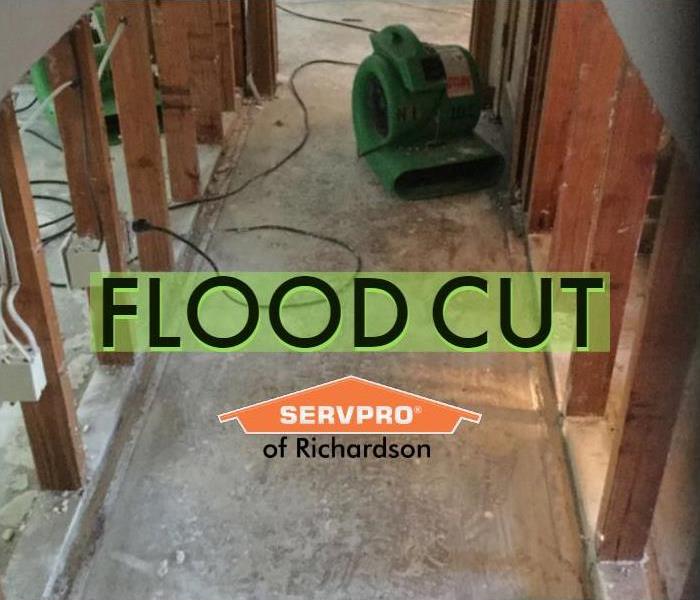 Flood cuts are cuts to a property’s walls, typically at least 12 inches above where the water rose up the wall.
Flood cuts are cuts to a property’s walls, typically at least 12 inches above where the water rose up the wall.
Flood cuts are cuts to a property’s walls, typically at least 12 inches above where the water rose up the wall. The end result is the wall being cut nearly halfway up (see photo).
Why are flood cuts necessary? And how can water damage restoration companies fix them? Let’s dive right in.
When is a Flood Cut Needed?
Flood cuts are most typically needed when rising water enters a property -- both residential or commercial. Rising water happens most often during:
- Hurricanes
- Severe thunderstorms
- Overflowed dams, rivers, and lakes
Although flooding is usually the reason for a flood cut, water damage restoration companies may also choose to use it in cases where other contaminants touch high into the wall. It’s not very common for this to happen during non-storm situations (for example, a pipe leak doesn’t usually cause enough damage to warrant this type of cut), but it is possible in extreme situations such as firefighting efforts.
Why Are Flood Cuts Needed?
Flood cuts are needed because rising water is grossly contaminated -- another term for this is Black Water or Category 3 Water.
With few exceptions, what Black Water touches cannot usually be cleaned. Drywall is a porous material (it absorbs what it touches, even with high-gloss paint) and is one of the items that cannot be sanitized, so its removal is needed to guarantee the cleanliness and safety of inhabitants.
The affected drywall is cut away, bagged in thick plastic, and disposed of. Due to the level of contaminants on the wall, cut drywall should not be handled without personal protective equipment such as medical-grade gloves, safety glasses, and a respiratory mask rated at N95. Any powder left behind after the demolition should also be vacuumed using HEPA filtration.
House Decontamination Before and After Flood Waters
Taking out the affected walls isn’t enough to properly decontaminate a home or business after rising floodwaters have entered. All affected areas, including floors, furniture, clothing, and other items also need to be cleaned.
The SERVPRO of Richardson water damage restoration process during storms helps our technicians the property's inhabitants have a clean space in which to work and live in.
Property Decontamination
- Clear every affected room of items. Clearing the room gives us full access to the floors.
- Apply an EPA registered bactericide, fungicide, and virucide to all surfaces in the room. The agent is allowed its full dwell time for the agent to effectively eliminate the contaminants. This step gives our technicians a safer environment in which to perform flood cuts and continue the restoration process.
Cleaning Household Items
- The items that can be safely decontaminated are taken back to our cleaning facility for processing.
- Items that cannot be decontaminated are documented for an insurance claim and disposed of after we have the permission of the owner.
- Items that can be saved are ATP tested post-cleaning to scientifically validate our cleaning process and ensure the owner their items are safe to handle again.
- Long-term storage is available in our facility when necessary. The cost of storage is typically covered by insurance.
- When the owner is available is to receive their items, they are delivered and unpacked by our technicians.
Why is Rising Flood Water Contaminated?
Even though it might look clean, rising water is always considered to be contaminated because we don’t know what the water has mixed with outside before it made its way into the property. Consider the probable biohazard rising water has touched outdoors -- oil, gasoline, poisonous pesticides, animal waste, fungi, etcetera.
Reconstruction After a Flood Cut
Once your home is dry and clean, all the structural elements of the property that were damaged and needed to be demolition need to the reconstructed. This is the last step your property needs in order to be move-in ready.
We usually see reconstruction needed for:
- Drywall
- Flooring
- Kitchen Cabinets
- Bathroom Cabinets
- Paint
If you are filing an insurance claim, we will work with your insurance adjuster to get your claim approved. If all or a portion of your claim is not accepted, we can still work with your directly to rebuild your home.
Buying Flood Insurance
When an insurance claim is denied during a storm situation, it’s usually because the homeowner does not have flood insurance. This type of insurance covers property damage caused by floods; contents (everything inside of your home) are additional coverage that we highly recommend. Visit the National Flood Insurance Program for more information.
Hiring the Right Flood Restoration Company
When your home has been affected by flooding, it’s likely that many of your neighbors have been affected, too. When the storm has caused enough destruction to warrant a national response, we recommend you hire only reputable companies to trust your home’s restoration to.
When hiring a flood restoration company, look for:
- A professional and well-established presence online. Is there information easy to find? Are they easy to get a hold of? Where is the company based out of? How many years have they been in business?
- Are they a local office or have they traveled to your location? It’s very common for national companies, like SERVPRO, to travel to hurricane and other storm-related areas to help the local franchises meet the demand of their services. A company that is not local is still fine to work with as long as they have national connections to guarantee you will still get the help you need should they return home.
- A company that has experience and success filing claims, especially flood insurance claims. Ask: have you restored flood-damaged homes before? How long does it usually take? What are your procedures?
- Read more about hiring reputable disaster restoration companies.
We’re a Water Restoration Company with Nationwide Reach
While our headquarters is on the border of Richardson and Plano, TX, our franchise travels nationwide to assist any community in need. We have over 30 years of experience in disaster restoration, and we have traveled to many hurricane, tornado, and hail-affected communities.
Our team of administrators has successfully processed thousands of water damage claims, and we can help you, too.
Contact us or give us a call anytime. We’re here to help!
What do Water Damage Restoration Companies Do?
8/13/2019 (Permalink)
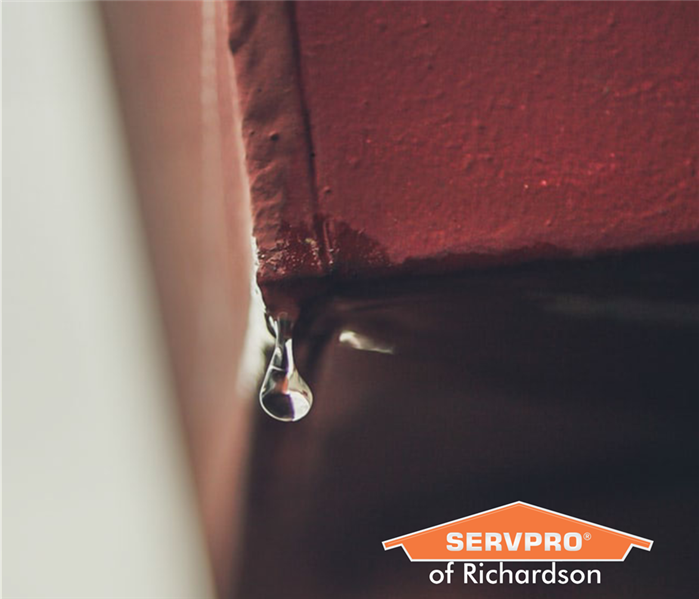 Water damage restoration companies clean and restore properties affected by water damages including floods, plumping failure, and firefighting.
Water damage restoration companies clean and restore properties affected by water damages including floods, plumping failure, and firefighting.
A water damage restoration company restores a property that has experienced water damage. Some restoration companies handle only a small portion of the water damage like water removal and drying, while others are full-service and can handle everything a property needs to be fully restored.
Before we get into the details of water damage restoration, let’s take a deep dive into what water damage is.
What is Water Damage?
Water is a vital commodity; without it, life isn’t possible. But too much water in the wrong place can cause chaos – particularly in residential and commercial properties.
Water damage is the catch-all name given to the damages caused by water being where it shouldn’t. We see thousands of water damages every year, and the most common causes are:
- A kitchen flooded due to a pipe burst.
- A wet ceiling and floor flooded after an attic water heater burst.
- Storm damaged properties. Storms can be severe thunderstorms or rising floodwaters.
- Damage caused by firefighting efforts.
- A small, unnoticed leak that eventually caused large mold growth.
Water damage covers everything from a ruined carpet or a broken appliance and it can lead to mold growing in flooded crawl spaces or between walls.
The causes of water damage are as varied as the effects; it’s not just a problem that affects houses in flood-prone areas. In fact (according to Insurance Journal) more than half of non-weather related water damage claims were the result of plumbing failures. Other causes of water damage can include a lack of proper weatherproofing, a washing machine or dishwasher fault, or using water to combat a fire inside a property.
Whatever the cause, water damage can be a costly and stressful issue to face. So what can be done about it?
Here’s a brief look at how water damages your home, and the repair process for setting that damage right again.
What Water Damage Does to Your Property
Water can damage your property in a number of different ways.
First and foremost, the presence of water can destroy electronics and appliances and damage or destroy a range of other possessions. Even items you may think of as waterproof can be affected, especially when the water is mixed with sewage, mud, or other pollutants.
Contaminated water is known as “grey water” when the contamination is mild or the pollutants are inoffensive. The wastewater from your shower and sink is a good example of grey water.
“Black water”, on the other hand, refers to water that is heavily polluted or contains traces of sewage. A flood which includes black water can be incredibly destructive, and continue causing damage even after most of the water has been removed.
As well as contaminating your possessions and your home, water can cause metal surfaces to rust, porous materials like drywall to become discolored and sodden, and laminated materials like plywood to warp and become delaminated.
Even a small leak can eventually turn into a big headache. Just a few drops of water each day causes moisture that can be trapped in between walls, under floors, or behind appliances. Over time, lingering damp can also cause mold spores to form. Mold isn’t just unsightly; it can cause symptoms, permanently damage the surface it's growing on, and can easily spread to cause further damage to walls and floors.
What is a Full-Service Water Restoration Company?
A full-service restoration company is one that doesn’t just deal with one part of the cleanup process after a water damage incident but instead handles the entire job from start to finish.
SERVPRO of Richardson is a full-service restoration company in Dallas Fort Worth. Rather than having to hire different companies to pump out water, assess the damage, and carry out repairs, many homeowners and renters choose to let us handle the entire recovery process as they focus on getting the rest of their life back in order.
Our full-service water damage restoration process varies from home to home, but the basic principles apply to every case.
Assessing Your Water Damage
In the case of water damage, a full-service restoration company will begin by making an assessment of the damage done. This includes inspecting damaged possessions and determining what can be saved or repaired and what must be disposed of or claimed against an insurance policy. They can also inspect the fabric of a property and decide how to approach removing water and repairing the damage.
Water Removal
The second step is to remove water from the property. This may be done using pumps or specialized water vacuums that can remove water from carpets, walls and other absorbent surfaces.
Drying
Once as much water as possible has been removed, the process of drying out can begin. This may involve using dehumidifiers and other specialized equipment to dry out the fabric of the building and remove moisture that cannot be seen or felt. Your full-service restoration company will have access to water-sensing technology that can tell when a surface is truly dry and when unseen moisture still remains.
Cleaning & Restoration
Once your property is dry, cleaning and restoration can begin. This may involve cleaning and refinishing items to their original condition. A full-service water restoration company can clean:
If your items need to be stored while your home’s restoration is completed, we also offer short and long-term storage solutions. Your items can be packed out and then returned to you at your convenience.
Reconstruction
Finally, if a property has experienced any damage to its structure, a full-service water damage restoration company will rebuild any part of it. Reconstruction is almost always approved as part of a homeowner’s insurance claim.
Our reconstruction services included:
- Carpet restoration
- Drywall rebuild
- Painting
- Flooring replacement
- Cabinetry repair and replacement
- Post-construction cleanup
- And more
A full-service company like SERVPRO of Richardson will handle every detail of the reconstruction, right down to sourcing paint and liaising with your insurance company. It’s our mission to restore a property to its preloss state and make any damage “Like it never even happened.”
Filing a Water Damage Claim
Many of our clients have never had to file a homeowner’s claim before. While it’s great news that your property hasn’t had previous claim, we understand this means that some guidance is necessary to feel comfortable during the process.
We work with every insurance company, and we help file thousands of claims every year. Our team of administrators work with insurance adjusters on a daily basis, and we know how to navigate the claims process. We’re happy to assist you as well.
Full-Service Restoration for Water Damage in Dallas-Fort Worth
SERVPRO of Richardson is a 30+ year veteran of water damage restoration. We are available to all residential and commercial properties in the Dallas-Fort Worth area. Our office is located on the border of Richardson and Plano, TX.
Working with our franchise gives you access to our decades of expertise, the most advanced specialist equipment, and our friendly and professional team.
Crucially, we are available 24/7 to attend immediately when disaster strikes, allowing you to begin the restoration process promptly and prevent mold and other damage from getting a foothold.
Do you have any questions or need a free estimate? Call or contact us today. We’re here to help!
Dallas Flooding Leads to Black Mold Removal
1/9/2019 (Permalink)
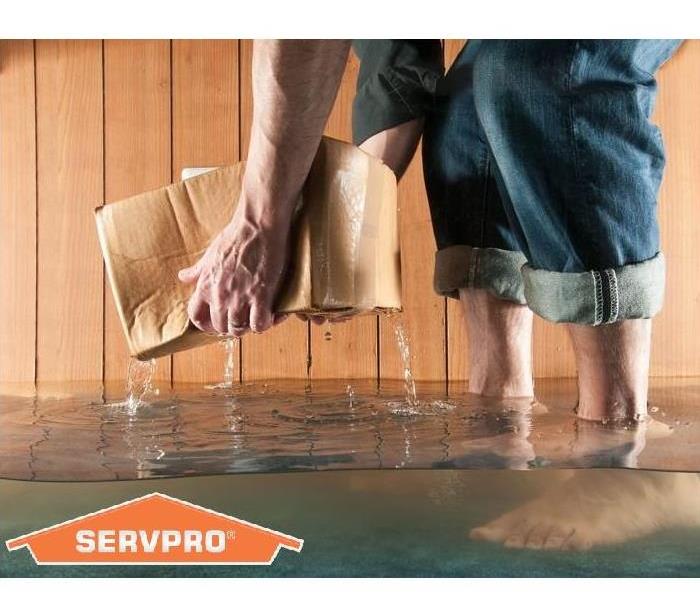 SERVPRO Richardson specializes in water damage restoration in Dallas Fort Worth. We've restored thousands of properties since 1986.
SERVPRO Richardson specializes in water damage restoration in Dallas Fort Worth. We've restored thousands of properties since 1986.
Water Mitigation and Mold Remediation in Dallas
What was already a difficult situation for the Johnson family became more of a headache when they found out their flooded home had mold growing underneath their flooring. The mold was discovered during water damage cleanup when a severe storm flooded their backyard and the water flooded their kitchen and living room. What was supposed to a typical flood repair in Dallas ended up also becoming black mold remediation.
Months before the storm, the Johnsons had what they thought was a small leak behind their refrigerator. They called a plumber who fixed the leak, and the family mopped up the water themselves. They thought that would be the end of their small water damage, but it was only after their floor was ruined after the storm and the boards were pulled up that they realized their previous water damage was actually the cause for mold growth underneath their wood floors.
Dallas Storm Damage
When a severe storm in Dallas dumped inches of rain in a matter of a few hours, the Johnson’s yard began to flood. The family attempted to keep the water out by putting all of their towels underneath their sliding door to their backyard. Yet, the water still rose above their door’s threshold when their drainage system became clogged from storm debris.
When our technicians arrived at the Johnson's house, the first thing we did was remove the storm damage debris from their yard in an effort to help the yard drainage begin to work. This helped alleviate some of the problem, but there was still water inside the house that needed to be extracted immediately.
Contaminated Water
Water from floods that rises from the ground up is considered to be contaminated. We consider this water to be Category 3 which means it has the potential to be hazardous to a person’s health. The reason flood waters are considered contaminated is because they have touched the ground where many pesticides and other unknown factors have mixed with it.
When our technicians are cleaning Category 3 water, they take into consideration the safety of all occupants. We spray sanitizer before and after water removal to make sure that everyone is safe during the water removal process.
Learn more about water categories by reading our article Classification of Water and Water Category.
Demolition
Because storm damage water is contaminated, properties that experience flooding need demolition. This is why many homes that needed flood cleanup in Texas after Hurricane Harvey had a portion of their drywall cut and removed. For the Johnsons, this was also the case. The drywall the water had touched was permanently ruined and had to be removed. Unfortunately, this was also true for their flooring in their kitchen and living room.
It was when the kitchen and living room flooring was being removed that we found mold growth underneath the boards. Because the family had called us immediately when the water came in from the storm, we knew that not enough time had passed for mold to begin growing from the storm’s water damage. Instead, what we found was mold from their previous water damage which we traced back to their refrigerator leak months ago that was not properly remediated.
It was at this point that what was already a difficult situation for the Johnson family became more of a nightmare as we needed to now include mold remediation as part of their cleanup project.
Mold Inspection
Upon discovering mold, our licensed mold contractor visited the Johnson’s property. The mold that was present in the house was on the kitchen floor and the adjoining living room floor. We came up with a mold remediation plan and got to work immediately.
Black Mold Removal in Dallas Fort Worth
In order to prevent the mold from going airborne and traveling to other portions of the Johnson’s family house, our technicians installed mold containment. Mold containment is when we isolate the mole infested areas in the home with a floor-to-ceiling covering. We also installed HEPA vacuums two remove airborne particles. For the Johnson family, this meant that mold containment was set up both in their kitchen and their living room.
With the containment set up and the HEPA vacuums running, our mold remediation technicians removed the Johnson’s flooring and began removing the black mold in their home.
It’s not uncommon to find black mold in Dallas Fort Worth, especially after water damage restoration. The natural environment found in our area of the world is conducive to this type of mold. While many articles have been written about mold symptoms related to the toxicity of black mold such as Stachybotrys Chartarum, there are actually thousands of different types of molds, many of which also have a black color.
Structural Drying
Because of the Johnson’s flood, we had to make sure that their property was properly dried. Correct structural drying helps prevent damage to walls and flooring, and it also helps prevent future mold. Our team set-up dehumidification equipment and created a drying plan. The Johnson’s property was monitored every day to make sure that our drying plan was proceeding and working to plan.
Homeowner’s Insurance and Water Damage Repair in Dallas
Every insurance policy is different, and only your insurance company can tell you what your policy covers in the event of water damage to your home. If your insurance company considers your water damage to be caused by a flood, they may not cover your claim. For this reason, it is important to consider flood insurance for your property, especially if you live in a flood zone.
Fortunately, the Johnson family had considered flood insurance before and purchased a policy that covered the cost of their storm caused water damage remediation. Their regular homeowner's insurance covered other costs of their mold remediation.
Flood Insurance
If you're unsure if you're living in a flood zone please check out FEMA's website here. Even though we do not live in a coastal region, there are still many flood zones in Dallas. If you are interested in purchasing flood insurance, contact an insurance agent that can sell you a policy.
To learn more about flood insurance, read FEMA's article The National Flood Insurance Program.
Reconstruction
Many water damage companies are only able to help you extract the water and dry your structure. But when demolition needs to happen and your drywall has been cut away and your floor removed, the next step to actually getting your property back the way it was before the damage is to rebuild what was torn out.
We are one of the few full-service Texas disaster restoration companies that can handle your Dallas restoration claim from beginning to end.
For the Johnson family, this meant that after we were done with their mold remediation and their water damage, our reconstruction team was able to get their homeowners insurance to approve the replacement of the drywall, fresh paint, new floorboards, and a new floor for their kitchen and living room.
In a matter of just a few weeks, the Johnson family’s living room and kitchen were put back together, and their disaster was “Like it never even happened.”
How to Prevent Mold Growth in Home after Water Damage
Whenever you have water damage, no matter how small it is, it’s a necessity to get your property dried. Mold grows and dark, moist environments and will continue to grow unless it is removed completely. Even a few mold spores can end up causing property damage if it's allowed to fester. There are many companies that offer mold clean up in Dallas. Make sure they are licensed by the State of Texas, and choose one that also offers reconstruction services in case they need to demolition any part of your home.
If you've taken care of what was a small water damage and you are wondering if you have properly dried your home, give us a call. We will be able to inspect your property and check for any wet spots that may have been missed.
To learn more about preventing mold after water damage, read our article.
Leader in Mold Cleanup and Water Damage Restoration in Dallas
SERVPRO Richardson is a trusted leader in Texas disaster restoration. We are an expert mold removal company in Richardson, TX, and we have helped restore thousands of homes and businesses in our hometown for over 30 years. We know how to properly clean and restore all properties, and we have performed residential and commercial restoration in Dallas, Fort Worth, Lewisville, Garland, McKinney, Waxahachie, and Plano, TX. Our SERVPRO in Dallas franchise also has a Texas Mold Remediation Contractor License. We offer free mold inspections in Dallas and all North Texas. Besides residential services, we also offer commercial mold remediation. You can trust us to handle all your residential and commercial restoration and cleaning service needs.
Our crews are available dispatch for 24 hour emergencies every day of the year. We can be reached 24/7 at (972) 986-7677. Call us any time!
Follow us:
Facebook Twitter Instagram Linkedin YouTube
We're a locally owned and operated business. Learn more about us.
“Like it never even happened,” only happens here.
Process for Water Removal in Dallas
12/21/2018 (Permalink)
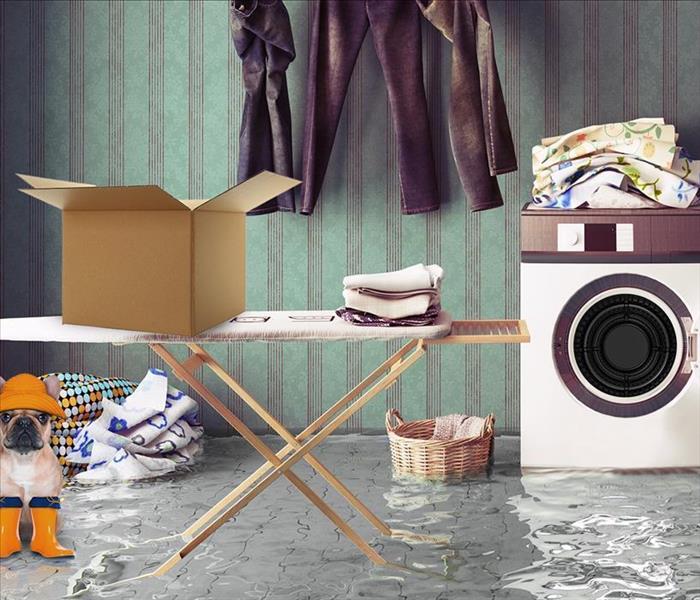 SERVPRO of Richardson is a leading restorer for water damages in Dallas, TX. We have restored thousands of properties since 1986.
SERVPRO of Richardson is a leading restorer for water damages in Dallas, TX. We have restored thousands of properties since 1986.
Do you have water damage in Dallas?
You may be wondering what is about to happen, how long the remediation process is going to take, and, if you’re filing an insurance claim, how to navigate this claim with your insurance adjuster.
While every property is different and requires its own plan of action, our office follows a general guideline for every water damage. This process has been refined for decades and is scientifically proven and accepted by the restoration industry.
Our franchise has successfully restored thousands of homes and businesses in Dallas Fort Worth since we began operations over 30 years ago.
When you call our franchise for water damage, this is what you can expect:
24 Hour Emergency Service
Our franchise is available for 24 hour emergency service. When you call, our on-call manager will ask you a few questions that’ll help our crew prepare for dispatch. We’ll ask for:
- The size of your property
- The number of rooms and affected
- The type of flooring in each room
- The source of the water damage
- Ask if you are filing an insurance claim
Cutting off the Source of the Water
It’s important to cut off the source of the water damage as fast as possible. Leaking pipes can be stopped by shutting off the water to that area of your home or by cutting off the water completely from the street. If you need assistance, please call a plumber.
If the source of water damage is from a leaking roof or ceiling, please let our on-call manager know so our technicians can be prepared to install temporary tarping.
If your water damage is the result of Dallas flooding or storm damage, please be aware that some insurance companies may consider this a flood claim. For more information about flood insurance, please see FEMA’s article on flood insurance.
Home Inspection
When we arrive, we’ll ask to inspect your property. We will start at the source of the water damage and work our way outwards. We may ask to go into rooms where the floor may appear dry. The reason for this is that we need to test the walls or ceiling to ensure no water is hiding in them. The goal is to find all the affected areas and prepare a remediation plan.
Insurance Documentation
We’ll start documenting the water damage by taking measurements, photographs, and taking a digital sketch of the affected areas of your room. All documentation is uploaded to a secure, proprietary program owned by SERVPRO. This documentation may be shared with your insurance adjuster if you are filing a homeowners insurance claim.
Our crew members will also ask you to sign documents authorizing us to start work at your home.
Disinfecting
If the water isn’t clean, we will disinfect the affected areas like the flooring and portions of the wall. Our disinfectant is EPA registered and OSHA compliant. It is used for the safety of all occupants in the building and our water damage technicians. It is sprayed and allowed to dwell for an appropriate time to be effective.
Water Removal
We will remove all standing water from the home. Water is removed using either portable extractors or a truck mount extractor that is attached to our service vehicle. Our technicians will move furniture as necessary to reach all the water. If necessary, they will also remove or detach the carpet and floorboards.
Carpet Removal / Drying Setup
If a room with carpet has been affected, our technicians will either remove the carpet or detach it. Our decision will be based on water classification.
If the water is clean, we will most likely only need to temporarily detach the carpet in order to set drying equipment underneath it. If the water is gray or black (contaminated), then the carpet is not salvageable and will have to be removed.
Our technicians will keep a sample of your carpet and take it back to our office where it will be tested for the color and textile type. We will prepare a report of your carpet’s type and send it to your insurance adjuster so it can be replaced with one of like quality and color.
At this time, our technicians may also have to remove baseboards and possibly drill small holes on the base of your drywall. The air holes will allow our equipment to dehumidify and spread warm, dry air and dry your property properly. Many times, the baseboards are salvageable and can be reattached to the walls after the drying process is complete.
Equipment Setup
We will set up the professional drying equipment around your home. Our most common equipment is the use of air movers and dehumidifiers. For larger properties, a desiccant is used. For a property with specialty floors or unique circumstances, other drying equipment may be used.
Our equipment will remove the humidity from the property and introduce warm, dry air into each affected room.
Please keep the following in mind:
- Our equipment will make noise. We understand the noise may not be ideal. All equipment we place is necessary to achieve a dry state at the speed we need in order to reduce the risk of mold growth. As we get closer to our drying goals, our technicians will remove the equipment.
- Do not move the equipment. All pieces are strategically placed.
- Do not shut off the equipment. Our machines are meant to be run throughout the day and night in order to achieve the results we need. Turning off the equipment will cause a delay in the drying process.
- Some equipment may appear to turn off at times. This is normal. The equipment is defrosting and will turn back on when it can continue the dehumidification process.
- Do you think a piece of equipment is malfunctioning? Give us a call.
Drying Monitoring
We will schedule a time to visit your property each day to monitor our equipment and record atmospheric readings. We use our data to validate our drying process. This data is also sent to your insurance adjuster.
How long the drying process takes depends on a variety of factors. Even the temperature outside can affect the speed of drying! Structures are typically dry in less than a week.
You don’t have to be home for our technicians to complete their daily drying monitoring. Just let us know you can’t be home, and we will install a temporary lock box to let ourselves in and out of your property.
Filing an Insurance Claim
We’ll do the majority of the heavy lifting to make sure your insurance claim is processed. When you experience water damage, give your insurance provider a call and receive a claim number. Tell them you have chosen SERVPRO of Richardson as your restoration provider. By law, your insurance provider must honor your choice of restoration company, regardless of what they or an adjuster suggest.
Then, give us your claim number and our office will contact your insurance provider to begin the claims process. Throughout the project, the documentation our technicians obtain will be forwarded to your adjuster. By the end, our invoice will be sent to your adjuster, and we will work with them to collect payment.
Our office works with all insurance companies.
Insurance Payout
Every job and every insurance policy is different, so we cannot say what your water damage will cost without visiting your property and visually inspecting the damage.
If you are filing an insurance claim, you will be responsible for your insurance deductible. This is the amount of money a homeowner owes before your insurance covers the rest of the invoice. Please ask your insurance provider what your deductible amount is. Your deductible can be paid directly to our office using a major credit card, wire transfer, or check.
What if your insurance won’t cover all or part of your claim? We will let you know what your adjuster has agreed to pay for. If there is work you need completed that isn’t covered, our office will work with you.
Water Damage Repair in Dallas
If your carpet had to be removed or any other portion of your home that needed demolition, our franchise can also rebuild anything that was affected. Don’t worry about hiring another business or a series of small contractors to put your property back together! Just let our office know you’d like to use our reconstruction services. We will send our reconstruction manager to inspect your property and add the rebuild portion of your claim to the documentation we are already sending your insurance adjuster.
Many families and businesses trust us to be their one and only disaster restoration company. We can handle your restoration from start to end. Working with just one business saves you time and stress. We are one of the few businesses in DFW prepared to handle every aspect of the claim, and we are ready to help you, too.
Do you have other questions? We’re here for you! Contact us.
Trusted Leader in Water Mitigation in Dallas, TX
SERVPRO of Richardson is locally owned and operated leader in the restoration industry. We have the expertise to handle any size fire and smoke damage restoration in Dallas, Texas. We have performed residential and commercial restoration work in Dallas, Plano, Frisco, McKinney, Ennis, and other North Texas communities for over 30 years. We also have a Texas Mold Remediation Contractor License and offer free mold inspections.
Our crews are available dispatch for 24 hour emergencies every day of the year. We can be reached 24/7 at (972) 690-1414. Call us any time!
Follow us:
Facebook Twitter Instagram Linkedin YouTube
We are family owned and operated. Learn more about us.
“Like it never even happened,” only happens here.
Water Damage Restoration Process Terms
5/8/2018 (Permalink)
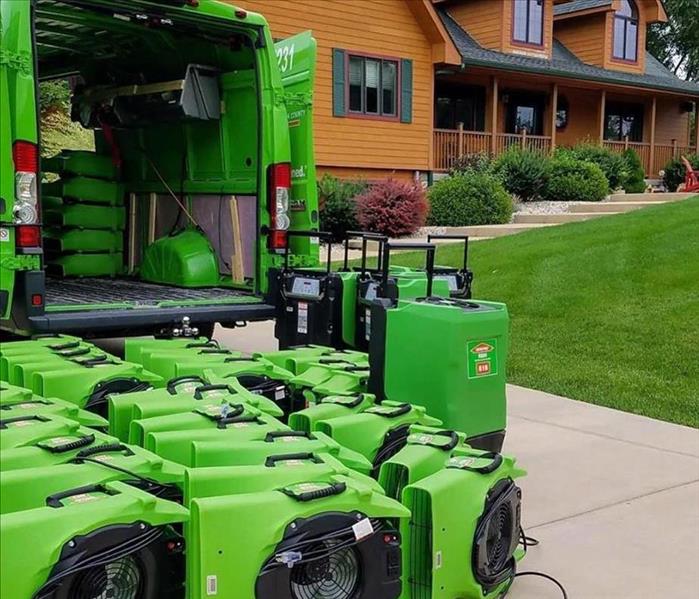 SERVPRO of Richardson is a water damage restoration company located on the border of Richardson and Plano, TX.
SERVPRO of Richardson is a water damage restoration company located on the border of Richardson and Plano, TX.
Water Damage Terminology
Discovering water damage to your home or commercial property is understandably shocking and overwhelming. You may find yourself asking:
What do I do?
Who do I call?
What will happen to my property?
What does this restoration process involve?
This article will shed some light on common terminology and processes in the business to help you understand more about water damage and resulting mitigation.
What causes water damage?
There are many potential causes of water damage. Maybe you’ve returned home from vacation and have discovered a leaky roof after days of storms. Or perhaps your plumbing system has malfunctioned, and your bathroom is now full of water.
Other possible culprits are dishwashers overflowing, water heaters cracking, washing machines breaking down, and natural disasters such as floods.
While it doesn't happen often, winter can also lead to water damages as low temperatures cause freezing pipes to burst.
Water Damage Quick Tips
First and foremost, the source of the damage needs to be addressed. If it is a leak, it needs to be fixed and the water shut should be off. Given the urgency of this, you may need to call your plumber to come out.
Second, call a water damage restoration company. It is imperative to remove the standing water and start the cleanup process to prevent further damage to your property and any belongings in close proximity to the affected area or areas. You will also want to make sure the restoration company you hire follows strict drying protocols to help prevent growth such as black mold.
Finally, you will need to call your insurance company about the situation.
If you choose to partner with us, tell your insurance company that SERVPRO of Richardson will be handling the water damage mitigation for you.
We are here to help! Our emergency dispatch can be reached 7 days a week, 24 hours a day.
After arriving at your property, our team of technicians will explain how we will go about handing your restoration needs. If you want to learn more about the water damage restoration process in advance, see our article.
Common terms used across the industry are covered below. You will probably hear many of them during your conversations with our crew.
Water Damage Cleanup Terms
PPE
PPE is the acronym for “Personal Protective Equipment”. Whether PPE is necessary for your situation will depend on the category of water damage that has occurred.
If PPE is deemed appropriate, our technicians will need to wear items such as impermeable gloves, safety glasses or goggles, overalls, Tyvek suits or full-face masks. PPE is essential for human safety in any hazardous work situation (RIA).
Category 1 Water
This category is also known as “Clean Water”. In this case, the water is not contaminated and does not pose a big risk to humans.
However, Category 1 water may turn into Category 2 or 3 as it becomes more contaminated. Typically, this can occur within three days. Most items can be salvaged from clean water so do not delay. Be sure to take the proper steps to begin cleaning up of any clean water damage as soon as possible.
Category 2 Water
Category 2, or “Gray Water” contains significant contaminants, and should not be consumed. The water does not contain human waste but may contain cleaning agents or condensate.
Carpets may be salvaged if soiled with Category 2 water, but some materials may have to be removed and disposed of. There is a risk of Category 2 water turning Category 3 if it is not promptly cleaned.
Category 3 Water
Category 3 water is “Black Water” and is majorly contaminated. This category is unsanitary and poses a significant health risk if consumed. Sewage and contaminated flood water are sources of category 3 water.
Usually, items dirtied and damaged by Black Water are not salvageable, but today’s restoration technology now allows us to salvage over 90% of your belongings (EPA). This is possible with the use of the Esporta Wash System, a wet-wash system that uses a mix of up to seven specialized detergents and hydraulic pressure to sanitize and remove over 99% of contaminants from your clothing’s fibers. Learn more about our process to clean clothing with Black Water damage.
Permeance
Permeance refers to the rate of water vapor through a material. Different materials have different permeance measurements due to factors such as their moisture barrier, composition, and thickness. Other conditions that affect permeance would be relative humidity and temperature. Some construction materials, for example, are already more water sensitive and have higher permeance. Generally, how much water vapor that can pass through a material will affect the mitigation process because extraction becomes more difficult. (IBEC). Some examples of higher permeance materials include flat paints and mesh. Whereas, lower permeance can be found in semi-glossy paint, glossy paint, and polyethylene. (UAF)
Moisture Barriers
Moisture barriers are used to help with moisture control. These materials reduce the rate that water vapor can move through a structure. Different solids hinder moisture at different degrees and include things like glass, sheet metal, rubber, coatings, and baseboards. (USDE). These barriers prevent moisture from penetrating wall surfaces, floors, and roofs.
Relative Humidity and Dew Point
Relative humidity refers to the amount of water vapor in the air in relation to the maximum amount that can be present in the current temperature conditions. Factors affecting relative humidity are changes in air temperature and amount of water vapor present or lost. In comparison, the dew point measurement is absolute and not relative. Simply stated, the dew point is the absolute amount of water vapor present in the air and this is useful in situations where predicting the occurrence of condensation is necessary.
Extraction
This refers to the removal of the water. After assessing the situation during their walkthrough, our technicians will start the process of extracting the water from your home or other property. It is important to begin this process as quickly and completely as possible to prevent any further, secondary damage.
Class 1 Water
While water categories consider the degree of contamination, water classifications pertain to the amount of water intrusion and materials affected. Class 1 water refers to cases where a minimal amount of water has flowed into the home or business and the materials affected have mostly low porosity. In these situations, there is little moisture retained and there is a minor amount of evaporation effort required for drying (IICRC).
Class 2 Water
In situations with class 2 water intrusion, a significant amount of water has flowed into the area and the materials sustaining the water damage are medium to high porosity. These items might be carpet or gypsum walls. Given the greater amount of absorption and retained water, more evaporation efforts are required to complete the drying of the materials.
Class 3 Water
With this classification, water has saturated materials within the home or other property but is still accessible to evaporation methods. Specialty equipment may be necessary to remove the retained water from the surfaces.
Class 4 Water
Lastly, class 4 water refers to when water has saturated materials and become inaccessible to conventional methods of evaporation. Potential materials that can be affected include plaster, soaked hardwood, or vinyl. Specialty equipment and significant drying efforts are required to fix these materials.
Read our article “Classification of Water and Water Category” to learn more.
Baseboards
You are probably familiar with this structure in your home. These are the boards that you find where the walls meet the floor. They are often decorative and are likely to be affected by water damage because of their proximity to the floor. Typically, our technicians will remove the baseboards during the drying process to ensure drying of the inner wall areas can occur.
Foundation
You may be familiar with this structure as well. The foundation is the part of the home or business structure that is located partly or completely below ground level.
Luckily, a lot of possible foundation problems involving water damage can be prevented. Learn how to prevent water from damaging your foundation and save yourself the trouble and expense of future repairs.
Chemicals
We find chemicals virtually everywhere in our daily lives in our kitchens, bathrooms, garages and elsewhere. Some are harmful to humans and the environment, so efforts are taken to reduce these risks. Others are used in specialized situations such as our proprietary chemicals used to remediate, restore, and clean your home or business. Upon request, you can access the Safety Data Sheets for our chemicals. An SDS is a document that outlines hazards, precautions, and procedures for a chemical.
Biocide
A biocide is a chemical used to kill living organisms (USDA). These can be natural or synthetic and we utilize these agents to sanitize areas affected by Categories 2 and 3 water damage.
Disinfectants
Disinfectants include chemicals and other substances that destroy unwanted pathogenic microorganisms, except for spores on inanimate surfaces. These agents are commonly used during various restoration cleaning processes as well.
Antimicrobial
Antimicrobial agents inhibit microorganism growth. Oftentimes, you can find these in over the counter consumer products used for household cleaning.
Air Movers
Air movers are not conventional fans. Rather, these pieces of equipment are used in the mitigation process to facilitate the drying of the water damaged areas in your home or business. They are high speed, promote evaporation, and the number of air movers needed to complete the job will depend on the size of the area.
Air Scrubber
Air scrubbers are high volume devices that remove contaminants, particulate matter, and odors from the air. The use of these systems will depend on the specifics of the damage to your structure.
Dehumidifier
The process of dehumidification includes the drying or removal of water vapor in a given area. A dehumidifier is a piece of equipment used to accomplish this. The number of dehumidifiers required to achieve the drying process will depend on the size of the affected structure.
Deodorizing
Deodorization is the process of masking or removing odors. When a smell remains on your salvaged items, our crew will take the steps necessary to deodorize them. Possible techniques include fogging, or the use of an air scrubber equipped with HEPA filtration.
Natural Ventilation
Natural ventilation occurs through openings such as doors, windows, and non-powered ventilators (IAVM).
HVAC
HVAC stands for “Heating, Ventilation and Air Conditioning”.
Salvageable
Salvaged, or recovered materials from your property can be saved and reused by you. Most items affected by Category 1, “clean water’ damage can be salvaged.
Unsalvageable
Unsalvageable items cannot be saved and reused. In instances of Category 2, “gray water” and Category 3, “black water” damage, carpets and other fibrous materials are not likely to be salvaged. Objects that are found to be unsalvageable will be reported to your insurance with the proper documentation.
Furniture Pads or Blocks
In order to prevent stains on your flooring, our crew technicians will place a small pad or block between the furniture and the floors affected by water damage. We want to prevent any unnecessary damage or distress to you and your home or commercial property.
Hardwood Floor Cupping
When wood flooring expands and contracts in response to changing moisture concentrations, you may see bends, cups or valleys in the wood beams. This means that there is too much moisture and possibly inadequate temperature control in the room or rooms. When water sits too long on a hardwood surface, you will see cupping develop.
If our staff finds any instance of this during the cleanup, they will prioritize extracting the water, drying and trying to save the flooring.
Buckling
This refers to when moisture saturation leads to structural deformation. When this occurs, you may see twisting, bending, or bowing. (RIA).
Subfloor
A subfloor is unfinished and serves as a supporting surface to a finished floor. It is possible for water to reach subfloor surfaces and proper drying measures would be taken to address this.
Monitoring
Day to day monitoring of the job progress at your home or commercial property is an important step of the restoration process. Every day, our technicians will pay a visit to the job, monitor the levels of drying that have occurred, assess the overall state of the area and remove, add, or change any equipment as needed.
Reconstruction
In cases of permanent damage to adhered or attached parts of your home or business, those compromised areas will need to be removed by our technicians. After drying the structure or structures, our reconstruction team will work with your insurance company on the rebuilding process.
Floods and Flood Damage
Flood damage is distinct from general water damage. Flood water is specifically implicated in damaging your structure, as opposed to other sources of water from inside your structure. North Texas floods are not unheard of and we can help you in the event you find yourself in need of water damage restoration following an episode of flooding. Such natural disasters have substantial human, social and economic consequences. It is always best to be aware of your own individual risk and location’s vulnerability to flooding.
Below we cover some terms related to floods and flood damage.
Floodplain
Floodplains are land areas that are susceptible to flooding. These low land areas are generally adjacent to bodies of water such as streams or rivers. (UWEC). The Federal Emergency Management Agency’s website offers detailed flood maps for public reference (FEMA). You can use these to see how close you live to a designated floodplain by looking up your home or business address.
Primary Flood Hazard
This refers to the effects of floods due to direct contact with the water. Examples of primary hazards are water damage to homes and their furnishings, automobile damage, structural erosion, and transport of large objects such as automobiles or outside structures like mailboxes.
Secondary Flood Hazard
Secondary hazards occur as a result of the preceding primary ones. For instance, drinking water supplies can become contaminated and electrical services may be disrupted.
Long Term Hazards
Long term hazards refer to long term changes that are detrimental to a community or region. These include changes to river channels, deposits of sediment that impair land use, and wildlife habitat destruction.
Does Homeowners’ Insurance Cover Flood Damage?
We cannot comment on your insurance coverage details. Each individual plan is unique, and you will have to contact your provider for the specifics.
Trusted Leader Fire and Water Damage Restoration in Collin County, North Texas
Widely trusted in the restoration industry for decades, we can handle any water damage emergency.
SERVPRO of Richardson is an independently owned and operated water damage restoration and fire and smoke damage restoration company on the border of Richardson and Plano, Texas. We have performed work in Dallas, Plano, Grapevine, McKinney, Frisco, Allen, and other North Texas communities in Collin County for over 30 years.
We also have a Texas Mold Remediation Contractor License and offer free mold inspections.
Our crews are available to dispatch and we can be reached 24/7 at (972) 690-1414.
Call us at any time!
How to Prevent Water from Damaging Your Foundation
3/27/2018 (Permalink)
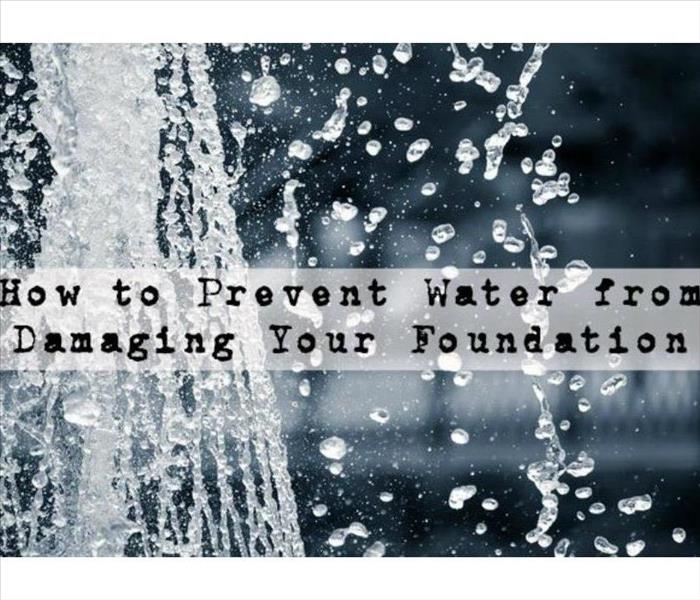 Preventing a water damage from affecting your foundation will save your home from expensive repairs later.
Preventing a water damage from affecting your foundation will save your home from expensive repairs later.
How to Prevent Water from Damaging Your Foundation
The foundation of your home is an important structural element. Without a good foundation, your home will be in big trouble. The house could shift dramatically, causing damage to the building. Thus, proper maintenance of your home’s foundation is essential.
Water damage is the number one culprit that weakens your home’s foundation. It can damage your home’s foundation in a variety of ways such as:
- Pooling – Water pooling on the surface around the perimeter of the house eventually degrades concrete and mortar foundations. Causes of pooling include:
- Downspouts that are too short, which allow discharged water to flow back toward the house.
- Overflowing rain gutters that allow cascading water to the ground.
- Poor landscaping that may cause water to stagnate.
- Groundwater – This is where hydrostatic pressure pushes against the underside of the foundation. This causes water to infiltrate the basement through cracks and joints.
- External pressure – This occurs when loosely packed soil adjacent to the foundation absorbs a large volume of water.
Repairing foundation damage can be expensive. Most homeowners will pay around $5,000 to repair foundation issues or more if the repairs are serious (Source: Granite Foundation Repair).
With that in mind, here’s how to prevent water from damaging your foundation.
1. Utilize berms or swales.
If properly built, berms can greatly reduce storm runoff. Berms are raised areas of ground that encourage water to drain downward, away from your home.
Swales are drainage ditches. They help prevent the foundation from becoming wet. Like ditches, swales collect stormwater from roads, driveways, parking lots and other hard surfaces.
2. Install a French drain.
French drains provide an easy channel for water to flow through. The drain includes a perforated or slotted pipe that helps direct groundwater or surface water away from a certain area, such as your home’s foundation.
Before installing a French drain, there are many factors you should take into account. For example, the drain flow, drain pipe length, drain aggregate, and the drain depth.
To site a French drain, look for areas where water pools for long periods of time. For example, areas like a basement, on the outdoor patio, and in the backyard.
3. Make sure the flower beds around your foundation have borders with openings.
If you don’t do this, water may pool around your home’s foundation. On the other hand, if your flowerbeds have borders with openings, water can run out of the beds and down into the yard.
For the bushes and hedges near your foundation, allow for sufficient air flow between them. This way, you’ll prevent the soil from retaining moisture and enable water to evaporate more quickly.
4. Install gutters with downspout extensions.
Rain gutters are designed to pull water away from your foundation. They are critical to protecting your home’s structural integrity. Downspouts are designed to move water away from your home.
Without gutters and downspouts, rainwater will flow off to the edges of your roof and onto the ground around the perimeter of your home. Also, if the downspouts are short, they may fail to carry water far away. This may cause disaster.
To solve this issue, install gutters with downspout extensions. The following are ways to extend downspouts:
- Install a hinged elbow. Extending the downspout using a hinged elbow allows for better drainage and freedom of movement.
- Attach a roll-up sleeve. Roll-up sleeves are perfect for those areas that need to remain uncluttered. A roll-up sleeve placed at the end of your existing downspout will sufficiently extend it to allow for drainage away from the home.
- Use a splash block. Splash blocks help to direct the water onto the lawn and away from the house. If you end up using it, simply place it underneath the downspout.
- Use a drainage pipe. This is a DIY project that any homeowner can perform. Simply dig a trench, lay the pipe and backfill it with soil. Besides the drainage pipe, you’ll also need adapters, couplings, T-fittings, elbows and other PVC specialty fittings.
5. Make sure that your lawn is sloped away from your home’s foundation.
Does your lawn slope toward your home? If so, it’s a recipe for foundation damage. Adjust it!
A lawn with an improper slope can result in serious damage to your home’s foundation. Besides causing potentially expensive foundation problems, an improper slope can cause other issues. For example, this can cause damage to sidewalks.
To keep water away from your foundation, your yard should slope at least six inches over a 10-foot span. This should give you at least a 2% grade. This way, any excess rainwater will drain away from your foundation.
Preventing water damage is a lot cheaper than paying for repairs. If you follow these five tips, you’ll not only reduce maintenance costs but you’ll also add years to your home.
Trusted Leader in Water Damage Restoration and Fire Damage Restoration in Collin County, North Texas
SERVPRO of Richardson is a water damage restoration and fire and smoke damage restoration company on the border of Richardson and Plano Texas. We have performed work in Dallas, Plano, Grapevine, McKinney, Frisco, Allen, and other North Texas communities in Collin County for over 30 years. We also have a Texas Mold Remediation Contractor License and offer free mold inspections.
Our crews are available dispatch for 24 hour emergencies every day of the year. We can be reached 24/7 at (972) 690-1414. Call us any time!
Follow us:
Facebook Twitter Instagram Linkedin YouTube
www.SERVPROrichardson.com
“Like it never even happened,” only happens here.
Cleaning Clothing With a Black Water Damage
1/14/2018 (Permalink)
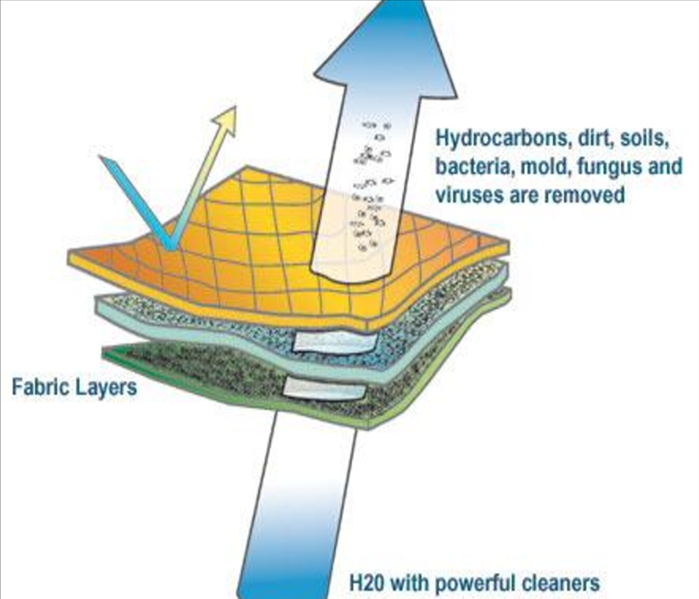 We use hydraulic pressure, which is a gentle way to push detergent laden water through the textile and rid it of contaminants.
We use hydraulic pressure, which is a gentle way to push detergent laden water through the textile and rid it of contaminants.
Cleaning Clothing With a Black Water Damage
Imagine flipping your house upside down. Anything that falls off the house and does not break when it lands are called textiles. Textile examples include clothes, stuffed animals, blankets, shoes, and towels.
When we’re called to a water damage, we often see the homeowner has tried to stop the spread of the water by putting towels or laundry on the floor. This is a common reaction.
Other times, the homeowner has no choice in what gets wet. When a leak or flooding is substantial, the water spreads to many rooms. Clothing, shoes, pillows, etcetera are on the floor and impacted.
The category of water affects how these affected textiles are cleaned. While many items can be cleaned at home using a traditional washer and dryer, there are other instances when specialized cleaning techniques have to be used to sanitize clothing and make it safe to wear again.
Water Category
Category 1 Water
When the water that wets the textiles is clean, that’s considered Category 1 Water.
Examples of Category 1 Water include:
- Tub overflow
- Sink overflow
- Broken water supply lines
- Falling rain water
- Broken toilet tanks without added chemicals such as bleach tablets
For Cat 1 affected textiles, throwing them into a laundry machine at home is an acceptable way to get them clean. Cat 2 and Cat 3 water damages are a different story.
Category 2 Water
Category 2 Water is called Gray Water. This water carries waste products and is not clean, but it also does not contain human waste.
Examples of Category 2 Water include:
- Toilet leak
- Washing machine leak
- Dishwasher leak
These leaks are considered Category 2 because of the chemicals used inside of them.
Category 3 Water
Cat 3 Water is called Black Water. This water is considered to be grossly contaminated and poses a significant health risk. Examples of black water include sewage or rising flood waters. These clothes need to be sanitized before they’re safe to handle again.
Examples of Category 3 Water include:
- Sewage
- Toilet leak that originates from the toilet trap (contains human waste)
- Flooding
Flooding is considered Category 3 because the water mixes with contaminants on the ground. Think about everything the falling rainwater can come into contact before it rises and enters your home. Contaminants usually include oil, salts, and trash from the roadways. It can also contain pesticides and other poisons that are used on your garden.
Cleaning Category 2 or 3 Wet Textiles
Many times, homeowners throw away textiles that have been affected by Category 2 or Category 3 Water -- Gray Water or Black Water. We see this often during storm related events when the number of people in need of emergency services. During Hurricane Harvey, we saw many families, unfortunately, throw away almost all of their home’s textiles.
But they don’t have to be. We restore damaged textiles in our Esporta Wash System, which sanitizes items and make them safe to wear and handle again.
For a thorough explanation of water categories and classifications, please read our article “Classification of Water and Water Category.”
Esporta Wash System
Unlike home washing machines or traditional dry cleaning, Esporta is a wet wash system. Our machine uses a combination of up to six environmentally friendly detergents according to the type of damage the clothing contains.
Textiles are placed inside the machine, where they spin in detergent-laden water while staying in place. Since the items don’t move inside the machine, the textiles are by hydraulic pressure instead of agitation. This makes the Esporta system gentle on all fabrics, even as contaminants are literally pushed out of the fabric by the detergent water.
The end result is textiles that are near neutral pH and food grade clean.
We are one of the few Esporta certified firms in North Texas. Our business has the unique capability of packing your damaged clothing and taking it back to our in house cleaning facility. Our Esporta cleaning technicians have cleaned thousands of pieces of clothing with a success rate of over 85%. This rate of success is among the highest in the clothing cleaning industry.
ATP Testing to Scientifically Prove Results
We prove the results of our wash system by using ATP testing. We take ATP tests of the textiles before washing and after. Pre testing proves to your insurance company that your item was contaminated enough to need our professional cleaning services. Post testing gives our customers the peace of mind that their clothing is safe to wear again.
The Textile Cleaning Process
If you have a water damage with affected textiles, trust us to clean them. While our crews are performing water remediation services, they will also collect all affected textiles from your home. We’ll pack your items and take them back to our cleaning facility.
If you have filed an insurance claim, we will contact your insurance adjuster and ask for permission to clean your textiles. In most cases, textile cleaning is approved. Immediately upon approval, your clothing will be washed.
When your clothing is clean, it can be placed in long term storage. Otherwise, it will be delivered back to you at your convenience.
The entire process is usually completed within two weeks of pick up. If you have items that you need ASAP, we can clean select clothing and return it to you within 72 hours.
Esporta uses hydraulic pressure, which is a gentle way to push detergent laden water through the textile and rid it of contaminants.
Trusted Leader in Water Damage Restoration and Fire Damage Restoration in Collin County, North Texas
SERVPRO of Richardson is a water damage restoration and fire and smoke damage restoration company on the border of Richardson and Plano Texas. We have performed work in Dallas, Plano, Grapevine, McKinney, Frisco, Allen, and other North Texas communities in Collin County for over 30 years. We also have a Texas Mold Remediation Contractor License and offer free mold inspections.
Our crews are available dispatch for 24 hour emergencies every day of the year. We can be reached 24/7 at (972) 690-1414. Call us any time!
Follow us:
Facebook Twitter Instagram Google+ Linkedin YouTube
www.SERVPROrichardson.com
“Like it never even happened.” only happens here.
Emergency Water Damage Services After Frozen Pipes
12/29/2017 (Permalink)
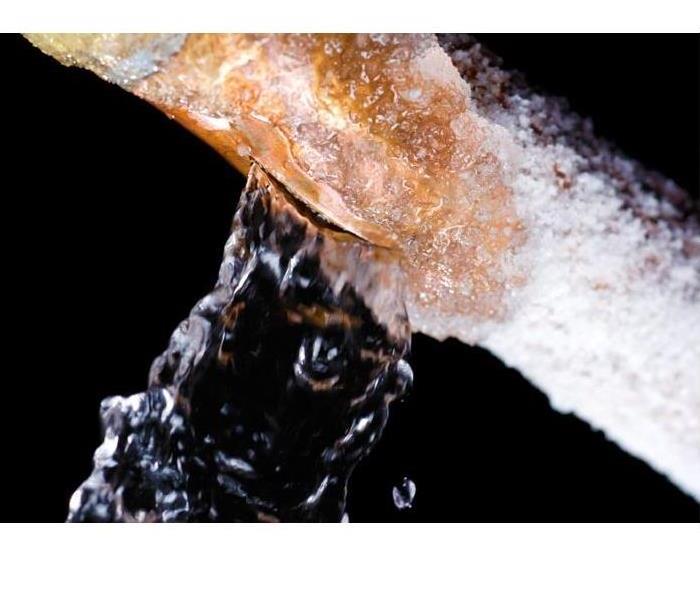 SERVPRO of Richarson has a 24 hour emergency line to receive all requests for emergency water damage remediation. Photo credit Mobile Home Repair
SERVPRO of Richarson has a 24 hour emergency line to receive all requests for emergency water damage remediation. Photo credit Mobile Home Repair
Emergency Water Damage Services After Frozen Pipes
It doesn’t happen often in Dallas, but severe cold weather is when our office receives a jump in calls from homeowners and businesses needing emergency water damage services.
The cause of the water damage is almost always the same -- a water pipe bursting after it freezes.
A water damage caused by a pipe bursting can cause damage to a property if it's not addressed quickly and correctly.
24 Hour Emergency Water Damage Remediation
Our office has a 24 hour emergency line to receive all requests for emergency water damage remediation. We can usually respond to all emergency water damage calls within 4 hours of a call, even in the middle of the night. If wintry weather conditions prevent us from meeting our 4 hour commitment, we will call to let you know. Our policy is never to promise a time that we cannot keep.
Don’t Wait for Water Cleanup Services
Secondary damage is the damage that is caused to your home or its contents when a water damage isn’t taken care of quickly. Some insurance policies may partially deny a water damage claim if they can prove a property owner purposefully ignores efforts to have their water damage taken care of in a timely manner.
Other reasons to call a water damage restoration company as soon as your loss occurs are:
Mold problems begin about 48 hours after a water damage.
The Water Damage will Expand
The longer water is allowed to stand, the more it will soak into the materials it is touching. This causes the water damage to expand and makes it more difficult to control. Water extraction should happen as soon as possible.
Increased Water Damage Insurance Claim
The longer materials are wet, the lower the chance they can be saved. This will increase the price of your insurance claim.
Water Becomes Contaminated
Water becomes more contaminated the longer it sits. Even if the water damage comes from a clean source, like a water tub overflowing, if the water is allowed to sit, bacteria will be introduced. If we do not remove the water, it will cause the severity of your water damage to grow and the risk of having to permanently throw away contents and structure increases.
Secondary damage from water is often preventable if you act quickly. Secondary damages include floors buckling and water being absorbed by additional materials that may have initially resisted it, like walls and furniture.
Mold Problems
If your property isn’t properly dried after a water damage, then mold and mildew may start to grow in as little as 48 hours.
Mold is a naturally occurring fungus. It’s present in all kinds of environments, both indoors and outdoors. Mold spores are microscopic and spread through the air, which makes mold growth easy when its disturbed by air. The best environment for mold growth is a dark, warm, and humid room. We often see the need for mold remediation in rooms where a source of water is introduced, like a frozen pipe bursting.
Our mold remediation specialists will inspect and dry wet areas. The area around the frozen pipe will also be inspected and dried properly. Many mold removal jobs we are called to do are due to slow leaking pipes that the homeowner, unfortunately, didn’t know about until the mold had eaten through their drywall and spread to other rooms of their house. Since we will need to cut through the drywall to reach the pipe, we will take advantage of this situation and perform a mold inspection to make sure mold growth is not a problem.
If the pipe is hidden behind drywall, rest assured that our reconstruction team is capable of replacing it after the pipe has been fixed.
Winter Water Damage Prevention
The best way to prevent water damages is to be proactive in its prevention. While it’s not always possible to prevent a disaster, the severity of the water damage is often lessened when homeowners are prepared.
What’s the weather forecast?
Keep an eye on the weather and prepare if below freezing temperatures are on the forecast. Be especially vigilant for winter weather storms.
A watch means the conditions are good for a winter storm to occur, but we’re not sure if one will happen or not.
This refers to a storm that will produce 3-5” of snow in less than 12 hours, sleet, freezing rain.
A freezing rain advisory means there will be ice accumulation of less than .25 of an inch.
A winter storm warning means there will be more than 6” of snow in less than 6 hours, more than 8” in less than 24 hours, or more than half an inch of sleet.
An ice storm warning means there will be more than .25 of an inch of ice accumulation.
Trusted Leader in Water Damage Restoration in Collin County, North Texas
SERVPRO of Richardson is a water damage restoration and fire and smoke damage restoration company on the border of Richardson and Plano Texas. We have performed work in Dallas, Plano, Grapevine, McKinney, Frisco, Allen, and other North Texas communities in Collin County for over 30 years. With our crews responding immediately to jobs, we are faster to any size disaster. We also have a Texas Mold Remediation Contractor License and offer free mold inspections. You can trust us to restore your home or business.
Our crews are available dispatch for 24 hour emergencies every day of the year. We can be reached 24/7 at (972) 690-1414. Call us any time!
Follow us:
Facebook Twitter Instagram Google+ Linkedin YouTube
www.SERVPROrichardson.com
“Like it never even happened.” only happens here.
Classification of Water and Water Category
12/29/2017 (Permalink)
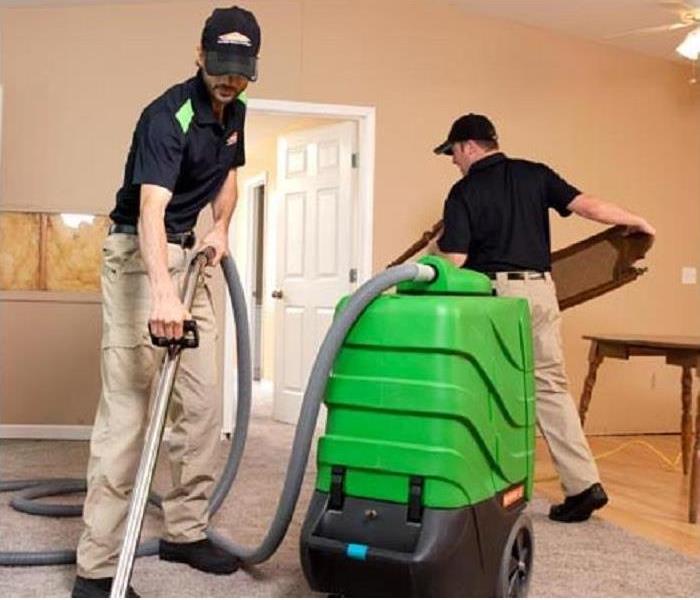 One of the first things our technicians note when they arrive is the category and classification of the water.
One of the first things our technicians note when they arrive is the category and classification of the water.
Classification of Water and Water Category
One of the first things our technicians note when they arrive is the category and classification of the water. We do this before starting emergency water damage restoration services because identifying the water serves an important purpose.
Water Category
The category of water tells us how dirty it is. Water can be categorized into three categories::
Category 1 Water or Clean Water
Category 1 Water means that the source of the water is sanitary. The water does not pose a substantial risk from dermal, ingestion, or inhalation exposure. Category 1 Water is called Clean Water.
Category 1 Water will eventually change to Category 2 or Category 3 Water if it is not cleaned promptly. Water changing categories is one of the reasons we respond to water damage restoration emergencies 24 hours a day. If water extraction isn’t prompt, the wet surfaces will run the risk of being permanently damaged. Add a water category change, and the possibility of remediation is lowered even more.
Category 2 Water or Gray Water
Category 2 Water contains significant contamination. It has the potential to cause discomfort or sickness if a human consumes or contacts it. Category 2 Water potentially has unsafe levels of microorganisms. It may also have organic or inorganic matter which may be chemical or biological.
When our technicians encounter carpeting wet by Category 2 Water, they will remove the carpet pad and dispose of it. The carpet itself might be saved depending on the carpet type and how many hours the carpet has been wet. If carpet delamination has occurred, the carpet is not considered salvageable.
If your carpet cannot be saved, we will take a sample of it. We use the sample to identify it, and then present this information to your insurance company to estimate its replacement cost.
Category 3 Water or Black Water
Category 3 Water is grossly contaminated. It may contain pathogenic, toxigenic or other harmful agents. This is the dirtiest classification of water. Another name for it is Black Water.
Sewage water and water from storm surges is considered Category 3 Water. Sewage contains human waste, and rising flood waters are contaminated by everything it has touched outside. Consider what the water will touch as it makes its way into your home. Examples include oils and trash from the street, lawn fertilizers, and much more.
When carpet is affected by Category 3 Water, both the carpet pad and the carpet itself are not salvageable. Our technicians will take a sample of it and present its information to your insurance company to estimate its replacement cost.
Why Categorize Water?
We categorize water for various reasons. One is to know the level of care our technicians must take to safely work. If the water is gray or black, we will a spray antimicrobial and antifungal chemicals to kill bacteria. This helps prevent further microbial growth.
Another reason to categorize water is to understand what wet materials can be salvaged or not. Materials in Category 1 Water have a high chance of being salvaged while materials in Category 3 Water have little to no chance of being restored.
One of the few exceptions to saving Category 3 Water materials is if the item can be sanitized in our Esporta Wash System. Our company is one of the few in North Texas that is a Certified Esporta Wash System Operator. This certification allows us to use the most advanced cleaning techniques and detergents in the clothing and textile industry. Our salvage rate is over 85%.
Classification of Water
Class 1 Water
Class 1 Water is when there is only a bit of water, absorption, and evaporation. It means that a portion of a room or area is affected. It can also refer to a larger area where the wet materials have absorbed moisture minimally. Materials that do not absorb moisture readily are those with low permeance. Little or no wet carpet or cushion is present in Class 1 Waters.
Class 2 Water
Class 2 Water involves a large amount of water, absorption, and evaporation. We use this classification when the entire room with carpet and pad is affected. However, the water has not wicked up the walls more than 24 inches. There is moisture in structural materials and substructure soil.
Class 3 Water
Class 3 Water involves the greatest amount of water, absorption, and evaporation. Water in this class may have come from overhead. Ceilings, walls, insulation, carpet, cushion, and subfloor in virtually the entire area are saturated.
Class 4 Water
Class 4 Water relates to specialty drying situations, such as wet materials with low permeance or porosity. These types of losses may require longer drying times and specialty drying methods.
Permeance
Permeance is basically is a measure of how much water can pass through an item. An example of a type of paint with high permeance is flat paint. Semi-gloss and glossy paints have more a barrier, so water can’t pass through them as easily. However, once the water does pass through, it’s a lot harder to get the water extracted.
Why Classify Water?
Classifying water helps us know what drying techniques to use, the amount of equipment to set, and how long the drying process may take. Our technicians will try to give you an estimate of the drying time, but there are many external factors that affect the timeline.
Rest assured that no matter the category or class or water involved in a water damage, we are prepared to help. We have seen it all, and we can help you through it all.
Trusted Leader in Water Damage Restoration and Fire Damage Restoration in Collin County, North Texas
SERVPRO of Richardson is a water damage restoration and fire and smoke damage restoration company on the border of Richardson and Plano Texas. We have performed work in Dallas, Plano, Grapevine, McKinney, Frisco, Allen, and other North Texas communities in Collin County for over 30 years. We also have a Texas Mold Remediation Contractor License and offer free mold inspections.
Our crews are available dispatch for 24 hour emergencies every day of the year. We can be reached 24/7 at (972) 690-1414. Call us any time!
Follow us:
Facebook Twitter Instagram Linkedin YouTube
www.SERVPROrichardson.com
“Like it never even happened,” only happens here.
The Science of Dallas Water Damage Remediation
12/28/2017 (Permalink)
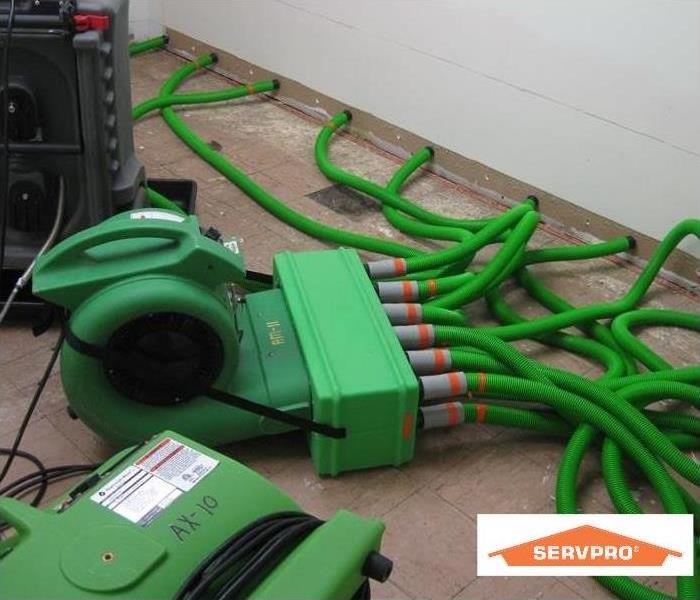 SERVPRO of Richardson is an IICRC Certified firm, and the majority of our employees have IICRC water restoration certifications.
SERVPRO of Richardson is an IICRC Certified firm, and the majority of our employees have IICRC water restoration certifications.
Using Professional Drying Equipment
Drying a residential or commercial property after a water damage in Dallas needs to be done correctly and quickly. Our home water damage restoration process has a scientific process and decades of experience to ensure your home does not experience any more damage. We use the right amount of professional drying equipment strategically placed to make sure your property gets dried properly and quickly. We use air movers, dehumidifiers, air scrubbers, and other specialized equipment as needed.
SERVPRO Water Damage Technicians
SERVPRO of North Richardson's technicians are trained in the science of psychrometrics. We are an IICRC Certified firm, and the majority of our employees have IICRC water restoration certifications. We follow strict restoration industry approved standards.
One of the basic lessons in water damage restoration is learning about psychometry.
What is Psychometry?
Psychrometry is the calculation of relative humidity and water vapor pressures from temperature and barometric pressure. It’s also called hygrometry.
We use the science of psychometry to know how to proceed with your water damage restoration. Every day we visit your property, we take careful measurements to know if our process is working or if it needs adjustment to dry your properly on time. We gather data such as temperature, relative humidity, and more.
Why Drying is Vital to Water Damage Services
Materials can often dry on their own if the moisture in the wet material moves to drier air (assuming there is drier air). An example that you probably see almost every day is a glass with a bit of water in it. After a while, that while will have evaporated and your glass won’t be wet anymore. It’s nature!
The problem with letting nature take care of drying your property is that it simply takes too long. The longer a material takes to dry, the higher the chances are for secondary damage. Secondary damage in a water damage involves mold growth and permanent damage of the wet material.
Avoiding secondary damage is the reason we use professional drying equipment, such as air movers, dehumidifiers, and other specialty equipment. The goal is to help nature by speeding up how quickly she works.
Our technicians know the most efficient way to dry your structure. We know which equipment to use, how much, and where to best place it so it can be the most efficient.
Monitoring the Drying Process
Our damage restoration technicians will visit your property every day to check the drying status of all wet materials and our equipment. We document different points of data on every visit and check it against our drying goals. If one room has met its drying goal, the equipment from that room is removed. This is one way where we make sure that we only charge for the equipment while it’s being useful.
If you have filed a water damage claim with your insurance company, all drying data is shared with them as we gather it. This gives your insurance adjuster proof that our company is taking care of you correctly.
The Goal of the Drying Process
Our efforts to dry your property don’t stop until we have proof your entire structure is dry. We consider a room to be dried to goal when its data points match a room that was not affected by the water damage.
SERVPRO DryBook Mobile
We document all drying data into SERVPRO’s proprietary program called DryBook Mobile. This is how we:
- Manage industry drying requirements.
- Provide real time documentation of the drying process. This documentation is given to your insurance provider if you file a claim.
- Validate our water damage restoration services are executed to standard.
- Report to all stakeholders involved.
- Allow real time updates.
Dallas Water Cleanup Services
We have a 24 hour emergency line to respond to any water damage emergency in Dallas Fort Worth. If your home or business has a water damage, we will:
- Dispatch a crew immediately.
- Perform water extraction services.
- Inspect your property to detect any wet spots.
- Measure the amount of moisture in the wet spots and create a drying plan.
- Set up professional drying equipment.
- Monitor wet materials every day to ensure they dry properly and quickly.
- Document all data.
- Present all documented data to your insurance adjuster to process your claim.
Water Damage Repair in Dallas
We are one of the few businesses in North Texas that can handle the restoration side of your water damage and also handle your water damage repair. We have a reconstruction division in our business that will work with your insurance company to approve any repair work.
Trusted Leader in Water Damage Restoration in Collin County, North Texas
SERVPRO of Richardson is a water damage restoration and fire and smoke damage restoration company on the border of Richardson and Plano Texas. We have performed work in Dallas, Plano, Grapevine, McKinney, Frisco, Allen, and other North Texas communities in Collin County for over 30 years. With our crews responding immediately to jobs, we are faster to any size disaster. We also have a Texas Mold Remediation Contractor License and offer free mold inspections. You can trust us to restore your home or business.
Our crews are available dispatch for 24 hour emergencies every day of the year. We can be reached 24/7 at (972) 690-1414. Call us any time!
Follow us:
Facebook Twitter Instagram Linkedin YouTube
www.SERVPROrichardson.com
“Like it never even happened,” only happens here.
I Need Water Damage Remediation in Dallas. What Now?
12/28/2017 (Permalink)
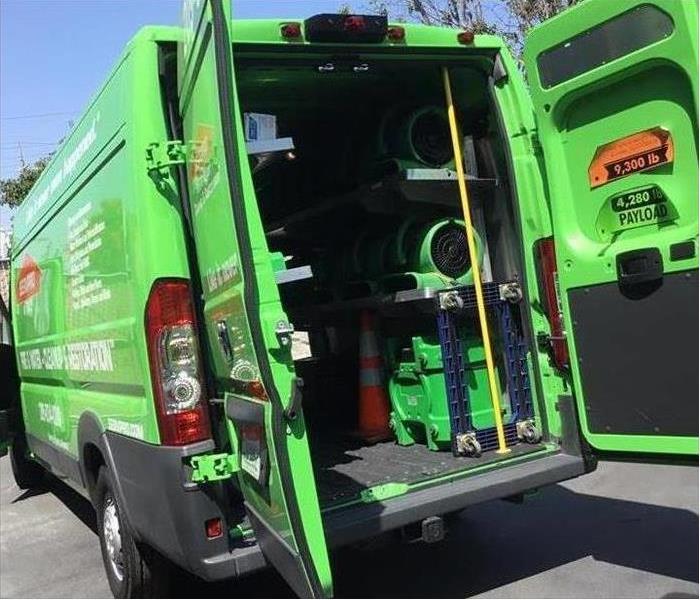 SERVPRO of Richardson is a water damage restoration and fire and smoke damage restoration company in Dallas Texas.
SERVPRO of Richardson is a water damage restoration and fire and smoke damage restoration company in Dallas Texas.
I Need Water Damage Remediation in Dallas. What Now?
Dealing with water damages is not something our customers ever want to do -- and with good reason. We understand the stress and inconvenience that comes when your bathroom, kitchen, or living room are suddenly flooded. Sometimes the homeowner may be present when the water damage happens and is able to shut off the water. Most of the time, a water damage is just a bad surprise that people come home to after a day of work or vacation.
We’ve helped restore many homes and businesses after a water damage. Our business has over 30 years of experience serving Dallas Fort Worth. We’re ready to help you, too.
#1 Call us. We Are Available for 24 Hour Emergencies
SERVPRO of Richardson's promise is to respond to all water damages within 4 hours of receiving a call. Our on-call manager will gather information about your loss and dispatch a crew of technicians immediately. We are available 24 hours a day every day of the year.
#2 Call your Home Insurance Provider
While we’re on the way, give your insurance provider a call and let them you’re in need of water damage services. Inform them that SERVPRO of Richardson is on the way. Some insurance companies may suggest another water damage restoration company, but the choice is legally up to you.
Learn your claim number and have it ready for our technicians. We will assign a Job File Coordinator from our office specifically to you. They will help guide you through the insurance claims process, and they will also work with your insurance adjuster every day to make sure your claim is processed.
#3 Water Removal
The SERVPRO water damage has been proven to work. When we arrive, we will inspect the extent of the water damage and begin extracting all the water. Our crew will document all affected areas and begin the documentation process for your insurance claim (even when an insurance claim is not filed, our documentation process is still the same).
It’s important to perform water removal services as fast as possible. The longer the water sits, the more it will soak into materials like floors and walls. Fast water removal also helps prevent mold damage and mold growth.
#4 Water Damage Drying and Monitoring
Once all standing water has been extracted, we will set up water clean up equipment to begin drying your home. We will place air movers, dehumidifiers, and other specialty equipment for hard to reach places. Our water remediation technicians know the exact quantity of equipment to use and where to place it to achieve faster drying results and efficiency.
We will return to your property once a day to monitor the drying process and remove or relocate equipment.
For more information about our drying process, read our blog “The Science of Drying after a Water Damage.”
#5 Reconstruction
After your property is dry and clean, we will send one of our Reconstruction Project Managers to assess any permanent damage the water may have caused. They will submit documentation and work with your insurance to get all necessary reconstruction approved. Once we get the green light from your insurance provider, we can repair your property. This service is part of what makes our office a complete water damage restoration service.
Full Service Emergency Water Fire Damage Restoration
We are one of the few water cleanup companies in Dallas Fort Worth that can handle your entire water damage restoration from beginning to end. We can be your one call and done.
When you choose us, a Full Service 3 Expert Team is assigned to work especially for you. This is a team consisting of a Project File Coordinator (works with your insurance), Restoration Manager (will manage the entire water damage), and Reconstruction Project Manager.
These people will be assigned to you and be your main points of contact for everything regarding your project. We understand stress levels are likely to be high, and we want to simplify the process and be here to help.
If you find your property has experienced a water damage, don’t despair. We’re an experienced, certified, and professional team that can help.
Does Homeowners Insurance Cover Water Damage?
Many homeowners insurances cover water damage, but the only way to be certain is to ask your insurance adjuster. Since your policy is a private document between you and your insurance carrier, we cannot read it ourselves and let you know.
If your water damage is covered, you’ll be given an insurance claim number by your adjuster. Provide us with this claim number, and the Job File Coordinator from our office that is assigned to you will contact your insurance company and begin processing your claim. We will be in touch with your insurance adjuster on a daily basis and make sure everything is processed correctly.
Trusted Leader in Water Damage Restoration Collin County, North Texas
SERVPRO of Richardson is a water damage restoration and fire and smoke damage restoration company on the border of Richardson and Plano Texas. We have performed work in Dallas, Plano, Grapevine, McKinney, Frisco, Allen, and other North Texas communities in Collin County for over 30 years. With our crews responding immediately to jobs, we are faster to any size disaster. We also have a Texas Mold Remediation Contractor License and offer free mold inspections. You can trust us to restore your home or business.
Our crews are available dispatch for 24 hour emergencies every day of the year. We can be reached 24/7 at (972) 690-1414. Call us any time!
Follow us:
Facebook Twitter Instagram Linkedin YouTube
www.SERVPROrichardson.com
“Like it never even happened,” only happens here.






 24/7 Emergency Service
24/7 Emergency Service


















